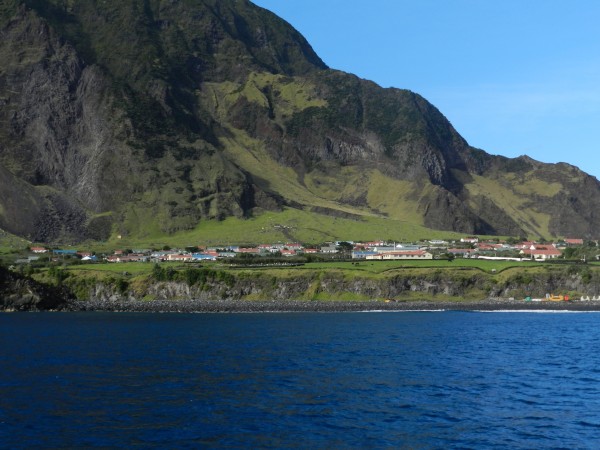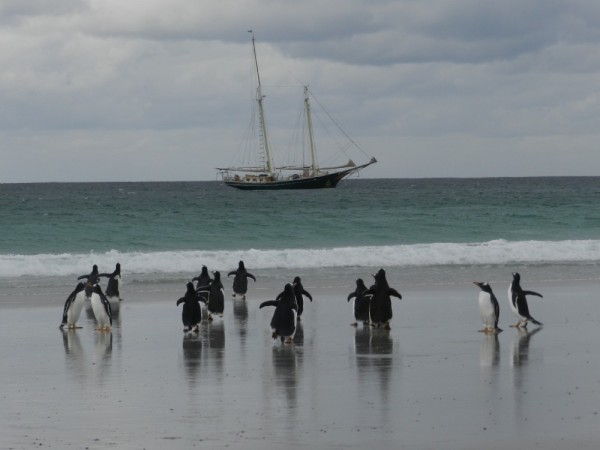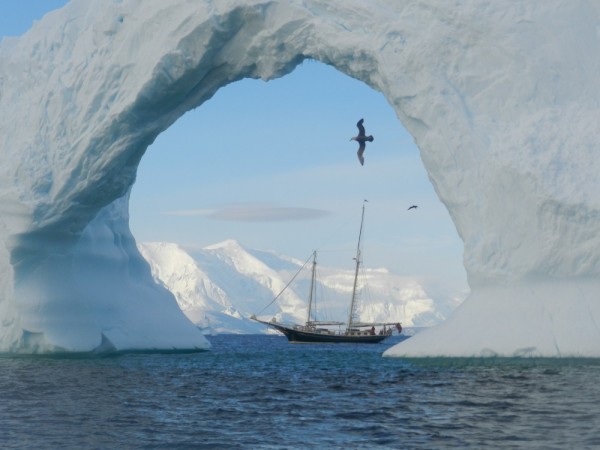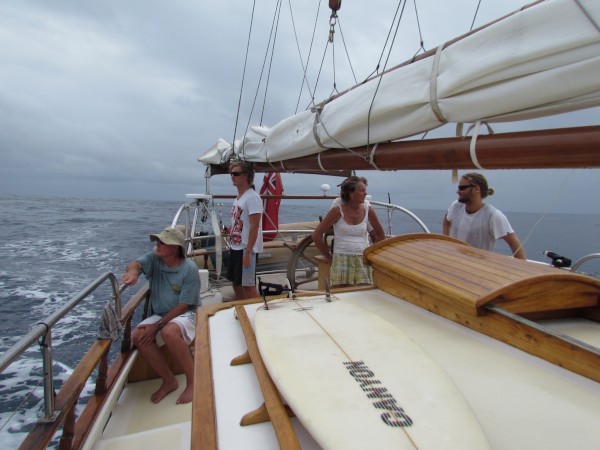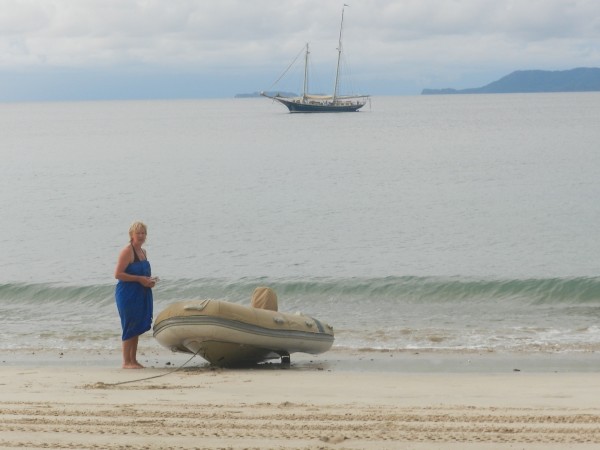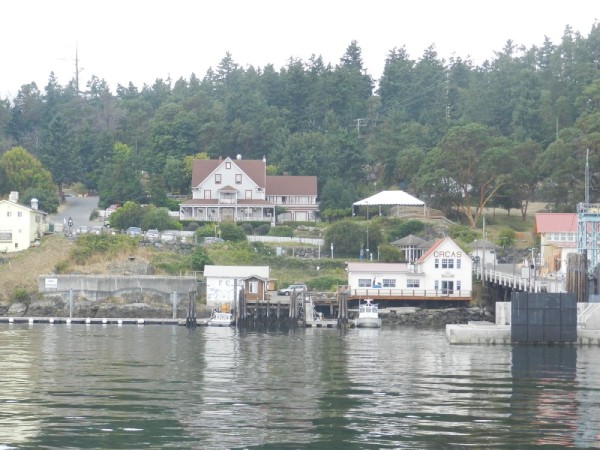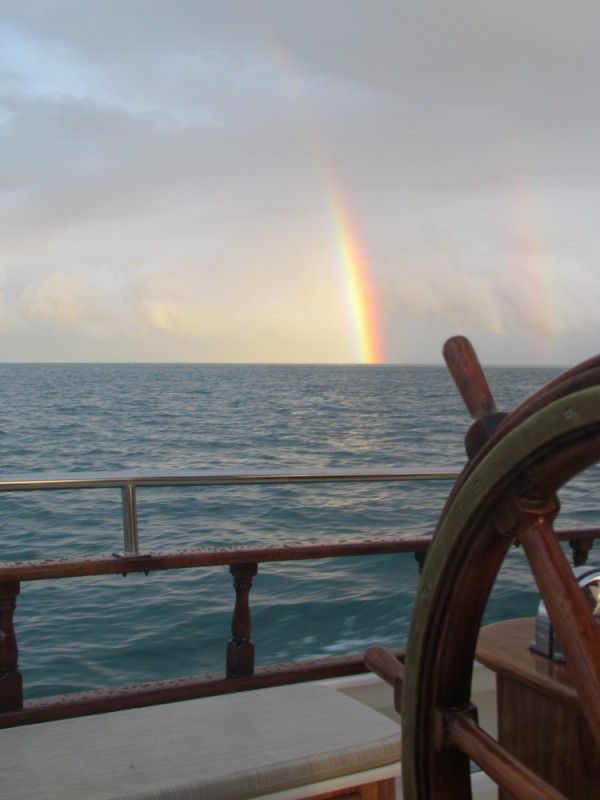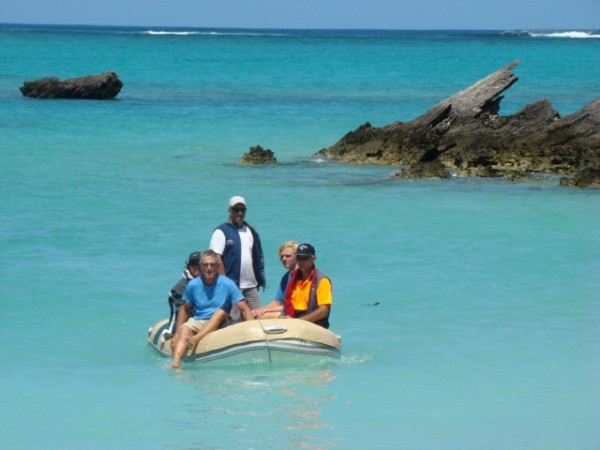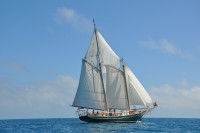Sailing around the world on the traditional gaff rigged schooner Windjammer
Off the beaten track & other interesting places
| Vessel Name: | Schooner Windjammer |
| Vessel Make/Model: | Pete Culler - Integrity Schooner |
| Hailing Port: | Airlie Beach, Queensland, Australia |
| Crew: | Ashley & Cathie Kerr |
| About: | We set off in December 2010 to continue our cruising adventures around the world after 25 years owning and operating a yacht charter company in the Whitsunday Islands - Australia |
| Extra: | |
| Social: |
01 August 2016
Reykjavik to Vestmannaeyjar Islands - Iceland
31st July 2016 This morning we waved goodbye to Maggie who heads back to University in Melbourne. Departing Reykjavik at midday we sailed with a light Nor wester around the end of the Reykjanes Peninsular and tied up in the fishing port of Sandgerdi. A very excited young chap who had had a good day fishing [...]
31 July 2016
Patreksfjordur to Reykjavic - Iceland
30th July A relaxed start to the day before motoring 30nm from Patreksfjordur past the bird breeding cliffs at Latrabjarg and anchoring near the "red" sand beach (Raudasandur). Roast lamb dinner. 24th July Light rain and low cloud lifted midday as we motored across the wide Breidafjordur to the Snaefellsnes [...]
22 July 2016
Isafjordur to Patreksfjordur - Iceland
20th July This morning Ashley and Cathie filled the gas bottles and we cleaned the boat. Leaving Isafjordur under a brilliant blue cloudless sky we motored across the still fjord waters to the island of Vigur. This island private island used to be a sheep farm, but is now a sanctuary for nesting birds, particularly Eider ducks. The female Eiders plucks down from her breast to cover her eggs and keep them warm. Part of this down is collected 2 to 3 times during incubation which encourages her to produce more. The very light, fine down is cleaned by machine and hand after heating to disinfect it. On Vigur they produce 60kgs of eiderdown each year and it the whole of Iceland around 3,000kgs are produced each year. It takes about 60-80 nests to produce one kilogram of down. Also nesting on the island are thousands of Arctic Terns which dive bombed us as we walked past their nests. Hundreds of Puffins were fishing for Capelin off the beach and had their nests in the grassy banks behind. Black Guillemots were nestling in nooks and crannies all over the property. We sat in front of the old farm buildings and enjoyed a cup of tea and some homemade cakes, soaked up the sun and watched the antics of the birds and a whale blowing out in the bay. Under way Ashley trawled for salmon, but they didn't take the lure so he changed the rig and stopped the boat for bottom fishing. Almost immediately 7 cod were on the deck. In the evening we stopped in the small fishing village of Bolungarvik to fuel up. After dinner we wandered the town and were asked in for a drink with the owner of the Einarshusid guesthouse. This old building was prefabricated in Norway and housed the large family of a fishing fleet owner. Unfortunately, all the 12 children and his wife died of T.B. but the house survives. It is a wonderfully comfortable relic with a marine theme and the salvaged wheel from the French wreck of the "Pourqui Pas" which foundered in 1936 on the south coast of Iceland. It also serves as the local's pub and restaurant. Apparently it is illegal to fish for Halibut in Iceland, but many people do including the owner who recently pulled in one weighing 98kg, so it is served here on the menu as "Big Flat Fish" rather Halibut. 21st July Departed Bolungarvik at 10.30am and had a good sail down the coast with a fresh breeze to Patreksfjordur. We moored in the harbour with a German Dufour called "Ruby Tuesday' moored outside of us. 22nd July A still overcast day beckoned and Cathie organised a hire car and we drove around to Raudasandur to visit the "red" sand beach. The long strip of sand enclosing the lagoon is better described as golden rather than red. The highlight of the day were the cliffs at Latrabjarg. Up to 400m high and 14km long, the cliffs provide a breeding roost for seabirds. In early summer it is estimated there are 1 million birds nesting along its length. The main species are Guillemot, Brunnich's Guillemot, Razorbilled Auk, Puffin, Fulmar and Kittiwake. Our favourites are the Puffins with their colourful beaks, squat bodies and large webbed feet. Between us we probably have enough Puffin photos to fill an album. We had a picnic lunch at the lighthouse here and then drove across to the Amsfjordur for a soak in a very hot thermal spring. On our way home we had a beer in Bildudalur before driving back to Patreksfjordaur. We dinner at the Stukuhusid Café and enjoyed a very good meal of fish soup, lamb fillets and meringue dessert.
19 July 2016
Isafjordur
18th July Our Iceland entry port is Isafjordur and we rafted up beside the yacht Aurora Arktika at 0600hrs local time. We advance our watches 2 hours forward to match GMT time. Isafjordur is a small tidy town and the gateway to the Northwest with an airport and ferry service. Situated near the entrance to the Isafjardardjup (fjord) which penetrates 40nm inland it is also a day stop for cruise ships. We had a relaxed day in town, a welcome hot shower and a sauna at the local pool. In the evening we ate out and tasted the delicious Icelandic lamb at the restaurant Husid. 19th July We were all up this morning to wave off Matt Po who is heading back to Germany and work. We will miss him as he has been good company and a good crewman. Murray organised a hire car for the day and we drove off along the coastal road. At Sudavik we visited the Arctic Fox Centre where we watched a couple of foxes being fed and listened to a short talk about them. Because of their threat to sheep flocks they are often shot except in the northwest national park. Until fairly recently, if a farmer had more than 6 sheep he was required to shoot 2 foxes a year or pay a tax. Today fox numbers are controlled by government shooters. The Arctic fox is much smaller than his red fox cousin and for a long time their pelt was sort after as a fashion item being draped around the necks of the "beautiful" people. Following the road to the head of the AlftaFjordur we stopped for an hours walk up the Valagil valley to a waterfall and gorge. The valley walls rise steeply up to 1,000m and the tops are remarkably even. Our lunch stop was at an old turf roofed farm house. The dry stone wall work on the old house and the stone fences is fantastic and grows a mottled rusty colour lichen. Perhaps the highlight of the day was a soak in a hot spring pool. Iceland has a lot of geothermal activity with numerous hot springs dotted about the countryside. This one, although on private farm land, was a simple small concrete pool by the side of the road with a small change shed. The water temperature was 44° C so it took a little time to ease into the water, but it was fantastic sitting there with the steep fjord sides rising above us and the sea lapping just below. We continued driving on for views of the Drangajokull icecap and a cold beer at a funny old hotel, which used to be a school, at Reykanes. The day had started with fog hiding the hill tops, but improved during the day and we had a lovely drive back along the coast with the soft evening light reflecting on the fjords and hilltop snow patches.
17 July 2016
Passage from Greenland to Iceland
15th July We departed Sermiligap at 0700hrs and motored north through the fjords to 66° 02'N before turning east and sailing from Greenland towards Iceland. There was a big swell and the wind was 15-20kts from the NE. We hoisted Main, Foresail and Staysail. The wind increased we had a very bouncy ride with bigger seas. We continued to see the high jagged snow-capped coast of Greenland for many hours and to pass the occasional iceberg far out to sea. Late in the evening with gusts over 30kts and the fog descending we put a reef in the Foresail and while we were putting a second reef in the Main the Foresail tore above the reefing point. We dropped the Foresail and Ashley decided to heave-to and ride out the weather for a few hours. 16th July After heaving-to for 4 hours we started motor sailing around 0330hrs with the wind25-30kts NE and a very uncomfortable sea on the nose. As the day progressed the wind gradually eased and we shook the reefs out of the main and rolled out the Balloon jib. 17th July The wind eventually died and we dropped the sails at 0330hrs. The stretch of water between Greenland and Iceland is known as the Denmark Strait and it has shown us several moods. From rough seas to calm and gale force winds to practically nothing. Now with 90nm to Iceland we are motoring over a smooth oily swell. Except for a few ripples on the surface it is hard to discern between the sea and the fog that envelopes us. During the afternoon the wind came in from the south and we sailed for a while, but it died and we were back on the motor. Removed Foresail from boom. Everyone on deck to help with the sail and for the first time in a while not needing full wet weather gear. Ashley restarted the heater and then later turned it off as unbelievably we were getting too hot! The water temperature today has gone from the 3-6° C we have had since Newfoundland to rise sharply to 12° C as we entered the warm Irminger Current that runs north along the west Icelandic coast. Consequently the air temperature off the water has improved noticeably and with it the interior temperature of the boat. First sighted Iceland on Murray's watch at 2200hrs. The sun stayed behind some cloud, but there was a glorious 3 hour red sky as the sun travelled across the northern horizon. We entered the Isafjardardjup Fjord at 0100hrs.
14 July 2016
Qutdleq - Sermiligac - East Coast of Greenland
11th July We left Qutdleq at 0500hrs with clear skies, but by mid-morning the fog had closed in and we didn't see the coast again until late in the day. Ashley and Cathie have decided to press on through the night to Tasiilaq. There is no wind to speak of and we continue to motor across the oily, gleaming, unruffled water surface. The Northern Fulmars fly in tandem with a mirrored image reflected in the glassy surface as they play around the boat. Several whales were spotted. Pilot, Humpback and during the night Murray spotted some Orcas. There hasn't been much ice during the day, but around midnight we passed through a large field of small bergy bits which are easily seen in the bright dusk, turning straight into dawn, twilight. At midnight the sun's glow on the horizon lit a golden path on the sea to follow north and illuminated the mountains to port. 12th July Another windless day of motoring north. A thin silvery cloud layer shielded the sun and the icy coastline emitted a luminous glow. A number of whales were sighted during the day including Long-finned pilot whales, Sperm whales and Fin whales feeding on Capelin (small fish). In the evening a pod of White-sided dolphins played around the bow. While we have been cruising around Greenland Cathie has called in to Aasiaat Radio twice a day with our position, destination and ETA. On one occasion, in the Fjords behind Nuuk, when Cathie was unable to contact Aasiaat they contacted Australia who in turn contacted Windjammer by email. Another time Cathie waited to call in until we had anchored later in the day and they said they had been searching for us, so they are very efficient. 13th July We pulled into Tasiilaq at 0215hrs and rafted up to a small coastal trader, the "Johanna Kristina". Spent the day in Tasiilaq. The laundry had hot showers, so luxuriated while the laundry was done. There is an interesting book shop with a very eclectic range of products and a helpful proprietor. He/she serves lunch, coffee, ice-creams and sells books, baby clothes and very slow internet. While in town the Johanna Kristina we were rafted alongside moved to the other side of the harbour and took Windjammer still moored alongside with her. Carl-Peter, a young local working as a sailor on the Johanna Kristina told us how lucky he was to have a job. Apparently most young people are unemployed. The locals fish and hunt whales and seals for their own consumption, but there is no fish processing plant here to earn cash, so welfare dependency is high. We anchored off in the afternoon as the Johanna Kristina and dredge were on the jetty and went ashore for a pizza and a beer. The pizzas were quite good, but because of the liquor licencing laws we had to go to the down stairs bar for the beer. 14th July Fuelling up was tricky as Ashley had to manoeuvre Windjammer stern to the jetty, with both boats still tied alongside, while Murray played tug with the tender. Mid-way through the re-fuelling the Johanna Kristina decided to slip her mooring and slide out from inside the dredge causing a few missed heartbeats on board Windjammer as we wondered what was going on. Departing Tasiilaq at 1100hrs we motored through some spectacular fjords before stopping at Ikatek to look around a WWII air base. This was a large American air force base, "Blue East Two", mostly used for search and rescue and now marked with thousands of empty rusting 44 gallon drums, the remains of a hanger and many trucks, some still with air in their tyres. The gravel airstrip, although unused, is still in good condition. We motored past a few very blue frozen water icebergs which are quite different to the common compressed snow icebergs. In the evening we anchored off Sermiligaq with 2 stern lines to the small jetty. Lots of children were sitting at the end of the wharf and when playing with the stern lines managed to let one go. Around 0100am Ashley heard some noise on board and was surprised to find 2 women in the saloon. They had been drinking and were after some more beers and a chat! All the children were still up and playing about at this early hour.
10 July 2016
Prins Christian Sund - South Coast Greenland
6th July - Continuing on the inside passage with low lying islands and a mountain range backdrop we made for Uunartoq. This island has the only hot spring in Greenland which has been popular from Norse times and mentioned in the Sagas. We anchored on the south side of the island and walked over the [...]
04 July 2016
Nuuk Fjords and heading south - West Greenland
1st July A crystal clear morning encouraged Ashley, Cathie, Matt and Maggie to walk over the hill to view the Kangersuneq Isfjord packed solid with ice. On their return we gathered mussels from the beach and as we up anchored and motored along Cathie created a delicious mussel and fish soup. Not a cloud in the sky as we cruised through impressive fjords to Qooqqut. Fashion ON the floe: Mid-afternoon, with a towering granite backdrop and sparkling seas we enjoyed another fashion treat. Matt (ice tester), Ashley (model) and Maggie (photographer) boarded a submarine shaped iceberg. With professional panache our model soon appeared in his trendy briefs (jocks) with straw hat, umbrella and crampon equipped Ugg boots. Paris eat your heart out! Matt, not to be outdone, stripped down too and rolled on the ice - proving that old ice is hard ice by skinning his elbows. In the evening we dined ashore at Qooqqut Nuan. We enjoyed a meal that included Musk Ox, lamb chops (NZ), scallops, prawns, shrimp, red fish and cod. Our excellent young waiter, Joorut, mixed us a Greenlandic coffee to finish the night! Irish whiskey - representing the man, Kalua - representing the woman, coffee - representing the arctic night, cream - the arctic snow and flaming Grand Marnier - the northern lights. Joorut also told us that anyone can apply for a permit to build a cabin along the fjords and that if the regional office approves the permit there is no cost or ongoing fees to use the land. #11 2nd July A 0600hrs start from Qooqqut motoring through the fjords saw us back in Nuuk by 0930hrs. We spent the day catching up on news, shopping and enjoying a free concert in the town square. There were a couple of pigs on the spit served with salad and potatoes and the local draught beer went down a treat. The old fellow who was tapping along to the music next to me was 88 years old. Almost everyone who passed him said "Hey" and touched him on the shoulder. It was a real family get together. We didn't manage to find any water to top up the tanks, but we fuelled up before leaving Nuuk and motored south for an hour to a sheltered anchorage, recommended by a local, for the night. Mussels from Kapisillit with pasta and a tomato sauce for dinner. 3rd July Weighed anchor at a leisurely 0900hrs and motored out of the fjords heading south. 1100hrs with a freshening cold N wind we raised sails including the Fisherman and sailed SE. The fog receded in front of us leaving a sunny corridor between the mountainous coast and fog shrouded ocean. 4th July The wind died in the early hours and we doused sails and continued on through the fog down the coast under motor. The sun fought a losing battle with the fog and despite thinning considerably we remained cocooned all day. In the evening the fog thickened and because of impending icebergs we began two man, two hour watches. 5th July Ashley plotted a course down the Inner Lead, threading down narrow passages through the coastal islands. We entered the first passage around midnight still in dense fog following the plotted course and monitoring the radar. Only the still water confirmed we had entered the channel until we saw peaks towering above the fog behind us, first to port and then close to starboard. As we passed deeper down the narrow tickle the fog cleared showing the bright sky with the midnight sun looming just below the horizon. Ashley timed the run through the narrowest part of the passage, where strong currents run, for slack water and we were glad we had good visibility as we slid between the rocks barely a boat length away on either side. It was good to have the sun and good visibility as this is a very scenic area. We arrived at Qaqortoq (Julienehab - most towns in Greenland have, confusingly, two names - the local and the Danish names) mid-morning. This is the biggest town in SW Greenland with a population of 3,000 with a Norse history, some lovely old colonial buildings and a growing tourist industry. We wandered the town and enjoyed a beer outside a central café where we could watch the locals go by in the sun. Mid-afternoon we fuelled up and took on water. Continuing on we motored around to Sadnoq. This is a small isolated settlement. Largely abandoned, with optimistically around 40 people remaining. We wandered around and came across some old graves made of slabs of rock and were probably packed around with earth and peat originally. That has weathered away and you can see the skulls and bones through the rock. We kicked a ball around with the local children and their dog. The Greenlanders we have met are very friendly and relaxed. The younger generation speak some English, but the men on the island didn't.
02 July 2016
Nuuk - Greenland
#10 27th & 28th June Two days in Nuuk, capitol of Greenland. Nuuk means "the headland" and the city sits on the end of a peninsular at the mouth of the vast fjord system "Nuup Kangerlua". We wandered into the town centre which is easily done as everything is close. There is an excellent museum which describes the different eras of inhabitants going back to 2,500 BC and up to colonisation by Denmark. There is a definite Greenland "look" influenced by their i=Inuit ancestry and the locals are cheerful and helpful and most have some English language. The city itself is not very inspiring with a lot of high rise apartments built in rectangular blocks, although a few traditional houses in the old town are quite picturesque. We definitely felt that we had left North America and entered Scandinavia as the modern shops were well stocked with everything you would find in Denmark. Unfortunately most of the cafes and restaurants seemed to be a bit un-inspirational and served fast food type menus. We saw a local street vendor selling dried whale meat, but no seal meat. The climate dictates the fashion and most wore jeans or slacks with warm jackets and boots. Wi-Fi is quite expensive, but we managed to get a free fix at the library. 29th June Having spoken to the locals, Ashley and Cathie have decided that rather than sail 300nm north to Disko Bay we will explore the extensive fjords of this area. What a good call! Today started off wet, cold and windy as we motored the two hours to Ikkuttut bay. Here we were out of the wind and Ashley and Maggie caught some lovely cod. They were hardly landed before being cleaned, filleted and pan fried by Cathie - delicious. After lunch we motored through increasing numbers of icebergs to Qoornup, a small community set up to survey the West Greenland in 1927. This small island has a fete every year on the first weekend of July, but we won't be staying around to join in. As the day progressed the weather improved and when the cloud lifted we could better appreciate the magnificent setting of chiselled granite mountains rising sheer from the iceberg cluttered waters. Glacial action has scoured out the sides of the deep valleys which carry tiny patches of tough native vegetation. Erik the Red, the Viking who landed here hundreds of years ago, who was accused of false marketing when he named the country Greenland to attracts settlers. 80% of the country is icecap and there are lots of bare rock, but there are green areas and apparently the Vikings ran sheep and cattle as the climate was milder back then. Leaving Qoornup after a good walk around we piloted Windjammer through numerous icebergs, bergy bits and growlers. It was difficult to find a safe anchorage clear of ice, but we found a good corner of Tasinsap Bay and reminiscent of Patagonia days we anchored with a line ashore by 2030hrs. Cathie bought fish in Nuuk which she was told was trout and she cooked it in the pan with a delicious orange sauce. A fine white flaked fish with a delicate flavour served with snow peas and wild rice. A wonderful way to finish an awesome day.
26 June 2016 | Nuuk, Greenland
"Eskimos and the Igloos" - Maggie reflecting on the present day Inuit communities we have been privileged to experience.
The sun was setting over the snowy mountain peaks as they took to the form of devils teeth, ascending from a dense mysterious fog lingering low on the ocean surface. As midnight approached, the tedious four day passage across the Davis Straight, had come to an end. We had sailed to the edge of the earth [...]
26 June 2016 | Nuuk, Greenland
Great new adventures and great new seas
Great new adventures and great new seas awaited as we prepared to cross the first section of the North Atlantic Ocean.The sun rose over Mary's Harbour, Labrador as we set sail for the the Davis Straight destined for Greenland. As much as I thrive in the excitement of wandering on new land, crossing oceans [...]
26 June 2016
Marys Harbour, Labrador to Nuuk Greenland
#9 25th June The wind died in the early hours and we dropped sails. It is a rainy grey morning. Around 0900hrs the wind built and we raised sails. The rain cleared and at lunchtime we had a short glimpse of the sun. The wind picked up in the afternoon and swung more to the west and we barrelled along at 7+ knots. The heater is going well after Ashley's work yesterday although there were hiccups this morning until he realised the engine vent cover was on which starved the heater of oxygen. Finished reading "Cod", an excellent book on the history of cod fishing and its impact on the culture and economics of many countries on both sides of the Atlantic. Maggie saw an iceberg on her afternoon watch, the first ice we have seen for a couple of days. 26th June The wind died in the very bright early hours of this morning and we dropped sails. The swell persisted which caused much rolling without the steadying of the sails. Grey skies and no wind and we are now over 62° north. There is no real darkness up here and you could happily read a book on deck in the middle of the night. Cathie spotted a lone iceberg this morning. Sea water temperature has dropped to 4.9° C. We spotted a couple more distant icebergs as we motored through the day with the ground swell only reluctantly abating. Maggie created a tasty vegetable curry for lunch. We sighted land at 2015hrs and as we approached Nuuk we were welcomed with a fireworks display ashore. A very cold breeze blew off the tall snow-capped mountains that tower over Nuuk. We rafted up in the inner harbour at 2300hrs having travelled 720nm from Mary's Harbour. Nuuk is at 64° N.
24 June 2016
Davis Strait
23rd June We haven't seen any ice since midday yesterday, but for safety sake we stand watches with 2 on during the darkest part of the night. One on the foredeck on ice watch and the other at the helm monitoring the radar. It never got completely dark as we had a clear night sky with an almost full [...]
22 June 2016
St Marys Harbour and departure for Greenland
#7 21th June A clear sunny day in Mary's Harbour. The mayor, Alton Rumble, told us there is now a population of 300 in town. There are not many options apart from fishing, so most of the younger generation have gone to St Johns or other major cities. We met several other Rumbles around town as they seem to have a share in the co-op fish processing plant, the port management, fishing boats and the town council. Alton kindly lent us his car to have a quick look around town (and that was driving slowly) and do some provisioning. The warm dry wind was ideal for drying out the boat and our wet weather gear. We also re-seamed some stitching on the mainsail and topped up the fuel using the longest fuel hose I have ever seen. They pull it 100m down the dock using a ute. Ashley and Cathie talked to the local fisherman about ice to the north. A tanker is stuck in the ice trying to get into Cartwright and the pack ice is well south so they have decide to leave Labrador in the morning and head under the bottom of the ice straight to Greenland. Also in Mary's Harbour was a nice 42' French designed Garcia aluminium yacht and its skipper Gilbert who at the age of 70+ years is going to sail solo through the North West passage. He came on board for a glass of wine and told us stories of losing his boat in Colombia and also rescues in Greenland and Iceland! 22nd June Departed Labrador at 0500hrs and set a course NE to Greenland. A little rain overnight but the skies cleared and we motored with no wind. Looking back at the icebergs grounded along the coast we saw an interesting mirage effect. This Arctic phenomenon is known as a "superior image" or :fata morgana" and occurs when a warm offshore breeze flows over cooler air lying just above the cold sea water. Light travels slightly faster through warm air than through cold causing a light ray as it passes from cooler to warmer air to curve back toward the cooler air. This means that to somebody observing a distant object, say an ice floe, through air that is warmer above than it is below, the floe will seem higher that it really is; it will also be elongated vertically making it seem taller than it really is. Sometimes cooler air can act as a duct between layers of warmer air and images appear of objects below the horizon. At 1030hrs the wind came in from the SE and we set Fore, Main, Balloon Jib and Fisherman. We passed through a band of "growlers" several miles wide, probably coming off the end of the coastal pack ice. These growlers range in size from that of a football up to the size of a container. I saw a wonderful iceberg mirage of a Tall Ship with sails furled on the yards floating above the horizon. We made good progress under sail despite a confused sea and by 2200hrs when we lost the wind and lowered the sails to resume motoring we had covered 130nm.
21 June 2016
St Anthony to Marys Harbour - Newfoundland.
18th June We tidied up the boat and then took Don's ute into town to get gas, outboard fuel and do the laundry. Caught up with the news and chatted to Mich once we got Wi-Fi. Ashley made some modifications to the fuel lines to further improve the diesel heater operation while at sea. In the evening we dined at the Lighthouse restaurant. Lovely view over the passing icebergs and nice food. 19th June Hitched a ride into town and visited the Grenfell museum. Dr Wilfred Grenfell, a 27 year old medical doctor came from England to Labrador in 1893. There were no doctors and the standard of health was terrible. He spent the rest of his life establishing a health care service which included hospitals, nursing stations and hospital ships. In the afternoon we hitched a ride 30kms out to L'Anse aux Meadows. This is the only authenticated Viking site in North America and the earliest evidence of the eastern migration of humans from Africa meeting their western migration cousins. The Vikings arrived here in 985 AD, but it wasn't until 1960 that their settlement site was discovered for European culture by Helge Ingstad. The sod houses have been recreated and there is an interpretive centre with enlightening video. The thumbs took a little longer to work on the way home, but we all arrived back safely after once more enjoying the hospitality of the locals. Today was the warmest day of the trip, reaching 18° C. The bright sunny skies made a pleasant change to the foggy damp conditions we have mostly experienced. 20th June Left St Anthony at 0500hrs and motored until the wind came in from SW @ 20-25kts. Sailing with main, fore and staysail. Water temperature is 3.2°C which chills the wind considerably. We passed several scattered large icebergs along the way. These are generally stuck in shallower patches of water, 80m or less. In the afternoon we pulled into the National Historic Site of Battle Harbour. The entrance was down a narrow snaking Tickle past barren rocky outcrops that open out into the tight harbour lined with white washed buildings with red trim. This island community at its peak with cod fishing and to a lesser degree seal and salmon was the hub to a population, including the surrounding area, of 4,000 people. When the cod fishing finished most of the population was relocated, but the young unemployed were encouraged to restore the old buildings. Today it is a piece of living history that caters to visitors with day trips from Mary's Harbour and accommodation in the restored cottages for those that want to stay. We could have stayed the night at their dock, but we thought the $2/ft charge was a little steep, so we motored the 9nm to Mary's Harbour.
21 June 2016 | St John's
St Johns - Newfoundland
It was quite the shock when we sailed into the the busy commercial harbour of St John's, hosting cruise ships, large commercial fishing vessels and small boat tour operators. I had become so content with the pleasant and simple nature of the smaller fishing communities of Newfoundland that we had come [...]
19 June 2016
Lumsden Harbour to St Anthony - Newfoundland
15th June Departed Lumsden by 0530hrs and motored north. No wind but thick fog. Two on watch to look out for ice. The radar picks up bigger icebergs and even smaller bergy bits show as intermittent blips. There are some interesting names on the chart. Having crossed Hamilton Sound we motored up "Dildo Run" to the "Main Tickle". Large icebergs have landed on then north facing bays and we motored around several as we entered the small fishing port at Durrell next to Twillingate. The small museum in Durrell has a stuffed polar bear on display. The 2 year old floated south on icebergs and became a menace to residents when he landed here. They couldn't tranquilise him so they had to shoot him. Walking towards town we came to a shop doing wine tastings. The wines are made from berries mostly found locally. Rather than being full bodied berry flavour they seemed to just have a hint of berry taste. Visitors from Gander gave the six of us a lift into town in the back cab of their pickup truck. Gander was for a short period one of the busiest airports in the world when the USA closed its airspace after the 9/11 attack and all incoming trans-Atlantic flights were diverted here. The locals opened their homes and looked after the flood of stranded passengers. We had a beer at the Anchor Inn with our transportation hosts before walking down the road to Addy's Fish Restaurant where we tried Capelins, small sardine sized fish. They had been baked and were very dry and salty - an acquired taste. Also on the menu were Cod Tongues which are highly prized, but we found them disappointing. Murray had some highly rated Snow Crabs and Maggie and I ate grilled cod fillets that had lovely and flaky white flesh. Ashley tried Moose Soup which he said was very salty. After dinner a short time with the thumb out soon had lifts with locals back to the boat. 16th June Departed Twillingate at 0500hrs motoring with no wind, grey skies and clear visibility. Very calm sea and a thin cloud cover around noon almost let the sun through. We covered the 80nm to Englee by 1730hrs. Englee is a small fishing village nestled in a cove near the entrance of Canada Bay. The fishermen were unloading Snow Crabs on the dock where we tied up. The town is quite isolated with no TV, population 400 and the Salvation Army building the biggest in town. 17th June We cast off from Englee at 0600hrs and headed north. Large icebergs have beached along the coast here and we saw a small section break off one as we passed by. It is blowing 15kts from the north and raining. We have better visibility with the cold northerly winds and despite the rain we can clearly see the icebergs and bergy bits, unlike the south westerlies that pick up moisture over the warm Gulf Stream waters which turns into fog over the chilly Labrador Current east of Newfoundland. A passage from John R. Bockstoce's book "High Latitude, North Atlantic" reads: "On the average the west Greenland glaciers calve about 27,000 icebergs each year. They then begin a 2-3 year voyage of about 2,000 miles, melting and calving as they travel, first north along the Greenland shore to Baffin Bay, then south, past Baffin Island and Labrador. On average about a thousand bergs per year reach Belle Isle, but most are bound down the east coast of Newfoundland to the Grand Banks where they meet the 60° F water of the Gulf Stream and vanish quickly." Now days this number could be more like 30-40,000 bergs heading south each year. The flat bergs are generally from the low lands around Baffin Island while the peaked ones are from the mountainous Greenland glaciers. The wind and sea built through the day and the motion stirred up sediment in the fuel tanks which caused a blockage in fuel filter which stopped the engine. We drifted for nearly an hour while Ashley changed the filter and bled the system. The wind was now blowing 40+ knots and the cold spray stinging our faces as we approached St Anthony. We dodged a final couple of bergs near the harbour entrance and entered quieter waters. Don, a trawler owner helped with our lines and came on board for a chat before we had a quick dinner and went to bed early.
15 June 2016 | Bonavista
Bonavista - Newfoundland
Bonavista is one of the oldest towns in Newfoundland and home of the Atlantic Puffin. Before spotting the vibrant orange and yellow parrot-like beak, I quickly mistook it for a penguin diving beneath the water in search of fish. They are quite a treat to watch, they lift off from the water resembling [...]
14 June 2016
St Johns to Lumsden - Newfoundland
13th June Left St Johns at 0500hrs. Fog and no wind with light rain. Wind came in from the SE and we raised sail at 0800hrs. The rain set in during the morning and we made good speed to the north in 15-20kts of breeze. We saw a number of icebergs - some well over 100m in size. Rounding Cape Bonavista we sailed into smooth waters and made 10kts down to Bonavista town in the freshening breeze. Ashley saw 32kts on the wind gauge by the time we were lowering the sails at the harbour entrance. Several locals braved the weather to assist us tie up at the inner fishing boat harbour. All lines secured by 1730hrs. Thoughts of a walk into town were dispelled by the rugged weather. Cathie cooked up a lamb roast with rice and veg and we turned in early. Along the way we have grappled with some of the local lingo, so here are a couple of terms we have picked up. Floater - Seasonal fisherman who leave at the end of the fishing season. Livyer - Those who choose to stay through the year Tickle - A short narrow channel between islands Rattle - A passage where currents can really boiled 14th June This morning we visited the "Matthew", a full scale replica of Cabot's 15th century carvel. Giovannini Caboto was a Genoese explorer, sponsored by the King of England, who in 1497 set sail from Bristol, England hoping to find a route to the Far East, but instead landed in Newfoundland. Instead of spices or silk he found cod which sparked settlement in North America and the establishment of the huge cod industry. Today in Bonavista fishing is still the main industry. With the 1992 moratorium on cod fishing still in effect, at this time of the year they are catching crab and lobster. We left Bonavista at 1330hrs and headed north. There is not enough breeze to sail and we motor across the lumpy sea in thick fog. There are a number of icebergs floating through this area which is known as "Iceberg alley". We maintain an iceberg watch on the bow and can only see 100m ahead at most. There is a tricky approach to Lumsden harbour with a buoyed passage between shoals and then a dog leg into a small fishing harbour. We only see the buoys through the fog when we are almost on them. A couple of local fishermen who came to help with our lines were impressed we got in. We were secure by 2030hrs. Cathie cooked up a pasta with the last of the scallops from Ramea.
13 June 2016
St Pierre to St Johns
9th June The storm has passed and we departed Saint Pierre at 0800hrs. A grey day with fog and a very lumpy left over sea. A light breeze turned to the SW and we motor-sailed with the main, fore and balloon jib. The wind died early in the afternoon and didn't pick up again until 2100hrs when we raised the sails again and turned the motor off. We sailed through the night at 6-7kts. The water temperature has dropped to 6° C, but it is quite reasonable on deck. We are standing 2 hour watches with 2 up. The barometer is reading 992. 10th June In the morning as we headed north we could hear the fog signal of Cape Race long before we caught a dim glimpse of it through the mist. As we approached Cape Spear Ashley spotted out to sea our first iceberg for the trip. Cape Spear is the most easterly point of North America. As we rounded the lighthouse there were many bergy bits calving off a large iceberg stuck against the shore. We entered St Johns harbour at 1800hrs and tied up in the security zone astern of the Venezuelan sail training ship, Simon Bolivar, to await customs clearance back into Canada from Saint Pierre. After a prolonged wait we cleared in without any problems or duty needing to be paid on our Saint Pierre wine purchases. Steaks were eaten at a dockside establishment before the younger folk took off to sample the delights of George Street. 11th June Went for a walk in St Johns and had a big cooked breakfast. Bought some camping mats as insulation to mitigate condensation in the forward berths we anticipate when we get into the colder northern climate. Received an email from Steph telling us she is engaged to Dylan!!! - much rejoicing in the Smail camp! In the afternoon we visited The Rooms Museum. This is an excellent display of the history and culture of the region. 12th June A sunny clear day for a walk around St Johns harbour entrance to Signal Hill. Cabot's tower on Signal Hill is famous as the site where Gugliemo Marconi received the first transatlantic wireless signal on 12th December 1901. Also at the tower we met the very handsome, 70kg "Chieftain", a 2 year old Newfoundland dog. This local breed is famous for their kind and water loving disposition. We walked past the tower and down to Quidi Vidi, a picturesque group of house built on the edge of a Tickle. We passed up a tour of the local craft brewery in favour of delicious fresh lobster rolls at the Mallard Cottage. We have enjoyed St Johns with its colourful terraced houses and broad selection of cafes, restaurants and pubs. Most of the pubs have live music and Matt says the party starts at midnight and they close at 3am. Matt gives George Street a 5 star rating. In June and July the weather is described as "Capelin Weather" as this time of year these small sardine like fish run and the weather is always wet and foggy. Maggie and I bought traditional sou'westers in St Johns. These hats are also known as Cape Annes' and are oilskin with a felt lining and flaps to cover your ears.
13 June 2016 | St Pierre
Where France meets North America
Following Windjammers extraordinary welcoming to Newfoundland, we headed south-east to where North America meets France. With Brie, baguettes and Bordeaux in mind, we set sail for St Pierre, one of the last two remaining islands belonging to the French empire in North America. St Pierre is like a little [...]
12 June 2016 | St John's
Newfoundland
The shiny green topsides and raking masts shined flawlessly in an otherwise dull morning as Windjammer took to its name as a "floating curiosity". Despite the long journey and early arrival from the opposite side of the world, I climbed out of the zodiac with great anticipation. The familiar sense of [...]
05 June 2016
South Coast of Newfoundland to St Pierre
5th June We left Francois at 0700hrs. Sea flat, no wind. 50nm to the island of Saint Pierre. The wind picked up mid-morning and we set main and foresail in 5-10kt breeze. The sea temperature here at 47° N is 8-9°C so any breeze blowing off it is very fresh. The sun is shining and we watched many Fin whales blowing just off the island. The first French island we passed was Miquelon and we arrived at Saint Pierre at 14.30hrs, but we had to adjust our watches forward 1 hour for French island time. Customs and immigration were waiting for us at the dock and were very pleasant. After we completed formalities we walked the short distance into town in bright sunshine. Being Sunday most shops were closed. We watched some local fisherman cleaning cod which they had caught on hand lines at 80-100m depth close to St Pierre. We called into the only bar open in town, the Txetxo. This is a Basque bar. The Basque were the first cod fisherman beginning fishing these waters in the 15th century. They supplied the European market with cod and jealously guarded their source. With Matt translating we had a good chat with Jose the barman. He worked the cod boats from the age of 14. He is proud of his Basque heritage and talked about his life and supplied us with tapas of whelks, cheese, salmon and sausage. He asked us back for lunch on Tuesday for a meal of traditional cooked Bacala. Back at the boat Cathie cooked up a wonderful risotto and Windjammer remained tied to the Eric Tabarly wharf for the night. 6th June It was a treat this morning to have croissants and baguettes fresh from patisserie. The yacht club has good showers and a washing machine so we tidied up before heading into town to the bottle shop. As this will be the best opportunity to buy good wine at a reasonable price we bought a good volume. Saint Pierre is a duty free port and has a long association of suppling alcohol. During the prohibition in the USA it was even one of the staging grounds for Al Capone. The wine and other liquor was delivered after lunch and Murray spent quite some time stowing it all aboard. In the afternoon Murray and I climbed up to the ridge above town for some good views of the island. Despite having a population of 6,500 the town is remarkably quiet with the locals friendly and considerate to pedestrians. 7th June (46° 47'N 56° 10W) Ashley has decided to wait in St Pierre for a strong storm cell to pass. I strolled into town to buy baguettes and croissants for breakfast. The sun has disappeared and the air is quite cool so I spent the morning reading on the computer and took a walk with Murray for a coffee break. We went back to bar Txetxo to have lunch with Jose and his special cod dish but he hadn't been able to buy any Bacala so he produced a family pot of steak and carrots with plenty of bread and also a scallop and saffron dish. He wouldn't take payment for the food as he doesn't usually provide food in the bar, but just enjoys cooking his family recipies. In the afternoon we took the tender over to I'lle aus Marin, the small island across the bay from St Pierre. The island was known as I'lle aus chiens (island of dogs) but they changed the name in the '60s. The island was the original centre for the cod fishing industry and in the late 1800s had a population of around 700. Today there are around 40 houses only and of these only 15 are original. Others have been renovated and there are some newer ones retaining the same architecture that are used as holiday homes. The cod fishing started to die out in the late 1930s and a number of houses were deconstructed and rebuilt in St Pierre. Some of the buildings are now museums recording the history and hardships of the residents. They were a very self-reliant and also strongly religious (Roman catholic) people. The biggest building on the island is the church "Notredame aux Marins". The museum curator did a marvellous job explaining the exhibits wearing only a t-shirt, long pants and gumboots while we were all rugged up to the eyeballs. 8th June Spent time this morning looking for insulation to go around the mast in the forecastle. The mast, being made of steel works extremely well in removing any traces of heat that might make their way forward from the diesel heater. The locals are all very helpful and a gentleman took me to his house where he had some insulation stored and gave it to me for nothing. It is a miserable day with strong wind and rain. The barometer is reading 999 and falling.
04 June 2016
Sydney Nova Scotia to south coast of Newfoundland
2nd June 2016 Arrived in Sydney, Nova Scotia at 2am and was met by Ashley and tendered out to Windjammer. Ashley and Cathie have sailed her up from Rhode Island where they had spent the winter. The rest of the crew, Maggie Kerr, Murray Spence and Matt Po arrived at various times on the 1st June. It is great to be back on board and share a new adventure with crew we have sailed with before. Sydney was famous for its coal mining and steel production. It was a gathering point for ships doing the Atlantic convoy crossings in the 2nd World War. These industries have stopped now and tourism is their mainstay. The cruise ship terminal has a small museum which records the early Gaelic settlers and later the battles for possession between the English and the French. A huge fiddle outside the facility is a reminder of the early settlers and their heritage of language and music. We departed Sydney at 1.30pm after fuelling and taking on water. A cold breeze was blowing in the bay but died out as we left the land and headed ENE on the 140nm crossing to Newfoundland. As we were motoring we stood solo 2 hour watches. A brilliant sunset over an oily calm sea was enhanced by the silhouettes of dozens of dolphins jumping and a few whales feeding. 3rd June First stop in Newfoundland is the small island of Ramea. The sea is flat calm and there is no wind. We arrived at 11.00am and tied alongside a large fishing boat. They were unloading scallops which they keep alive in the flooded holds. They generously gave us a basket of scallops and showed us how to shuck them. They did it very quickly and we ended up with several kilos of scallop meat. They also gave us some flounder fillets which Cathie cooked for lunch. Winston the skipper and owner was very proud of his vessel the "Burin Tradition" and showed us over her. He is licenced to fish for scallops, sea cucumber, whelks, cod and halibut and even allowed to catch 8 blue fin tuna a year. We had a walk on a board-walk out to the lighthouse. The country is boggy with stumpy little spruce scrub and weather rounded bare rock. We left Ramea after lunch and headed across to the main island of Newfoundland and entered the Grey River fjord. The town of Grey River has been largely abandoned as the fishing industry has declined since the moratorium on cod fishing in 1988. A local told us in his extremely broad accent there are only about 70 people left in town and only 14 children in the school. We anchored for the night a few miles up the fjord. We all battled to understand the Newfies "language". Their accent is quite unique and you need to listen very carefully to get their meaning. We dined in style with the fresh scallops cooked in ginger, sherry, soy and maple syrup and served with fresh asparagus and mashed sweet potato. 4th June Ashley changed the sump pump in the shower. It has lasted 6 years! We motored up the west arm of Grey River for a look around before heading out to sea and following the coast east to Lahme Bay. The coastline here is steep bare cliffs with little sign of vegetation. We entered Lahume Bay and anchored in Deadman's Cove. The massive hills here are well rounded by glacial action and waterfalls break the silence as they tumble hundreds of metres down the walls. We had a good climb up to the tops with views back over the bay and down on Windjammer at anchor. On the way down we noticed what we thought were white goats, but later we were told that they would have been young caribou. Leaving Deadman's Cove we motored 5nm along the coast to the small community of Francois which nestles at the head of a small cove with a backdrop of craggy cliffs and a river cascading through the centre of town to the sea. Like Grey River, this was a busy fishing village relying on the cod fishing but with its demise most residents have left. Today there are only 70 locals, but it seemed quite lively with several visitors staying in B & Bs ferrying in from bigger towns for the weekend. A quick stroll around the town was followed by pre dinner drinks on deck and then a delicious roast dinner. Later we went to one of the boat sheds where some visitors were having a sing along with guitar and lagerphone. Matt played some Spanish tunes and Cathie had a good bop.
09 May 2016 | Sailing to Nova Scotia
Sailing to Nova Scotia
The front has eventually passed and we are now on our way to Lunenburg. The extra two days dockside at Newport turned out to be quite productive and I was able to free up the engine stop cable that was forever challenging us to an arm wrestle. Cathie managed to add another ice breaker to her arctic collection [...]
05 May 2016 | Newport RI
Arctic Circle passage
Spring has finally arrived in Newport and it's time to get moving again. Just waiting for the weather front to pass, then we're off to Nova Scotia via Cape Cod canal and Provincetown on the end of Cape Cod peninsula. From there it is a 320 mile passage to Lunenburg where we start our meander up the coast [...]
Torshavn - Faroe Islands to the Shetlands
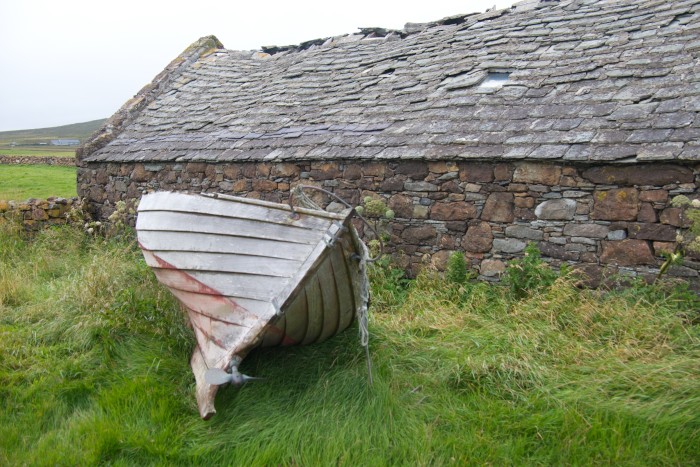
Torshavn is a mix of old and new with beautifully maintained old buildings around the point of Tinganes, with their turf roofs and the more modern homes stretching up the hillside behind. Tinganes means Parliament point and the Faroese claim one of the world's oldest having presided here for over a thousand years. The general assembly is known as the "Thing". Ashley suggested that the MPs should be known as "Thingamajigs".
The National Museum describes the development of the islands from their volcanic beginnings. In the early times the Faroese were subsistence farmers living on sheep and catching birds for food. At one stage 97% of the Faroese income was from making woollen socks for the King of Denmark which he in turn on sold to the army and navy. Fishing came later and is now the main source of income today. Most other trade is restricted to passing through Denmark.
After several sunny days, the weather took a turn for the worse with up to 50kts of wind and rain over night, so we took a bus trip up to Bordoy Island to get some perspective of the country. The excellent road network connects most of the islands skirting the coast and crossing the water via bridges or tunnels under the sea. Small farms line the steep green valleys and fishing ports dot the coast. There are hiking trails all over the island and an absolute paradise for bird watchers. The weather was wet and windy with a strong NWer gusting to 50kts.
A sailmaker that was recommended by one of the charter schooners collected our torn foresail and returned with it the following morning. On inspection we found that it had been repaired with dozens of little patches painstakingly sewn with a large needle leaving rows of rather large pin holes. The danger of course was that the first strong wind loading up the sail would have a zipper effect tearing the sail along the stitched seam. C'est la Vie
9th - 10th August - The Wind was forecast to ease so an early start was made from Torshavn and we cleared the harbour by 0600hrs. There was still a big sea running after the blow, but the steady 15-20kts NW gave us a good sail to the Shetlands. We are standing 2 hour watches so can catch plenty of rest.
We sailed around the Muckle Flugga lighthouse, built in 1857-58 by Robert Louis Stevenson's father Thomas, (The map in "Treasure Island" resembles a map of Unst) the northern most point of the UK, then down the east coast of the north island of Unst and into Balta Sound tying up at Sandison's wharf at 1800hrs. It was a relief to pull into flat water after such a bumpy trip.
On arrival we were met at the wharf by Penny and Gordon Thomson with a box of treats; bread, biscuits, fudge and a bottle of the local Reel gin and some tonic water. Murray knew Penny from way back in the 1980s in the Med and had advised her that we were on our way. They came aboard for a G & T 's before generously shouting us dinner at the local pub.
11th August - The day dawned windy and overcast. We walked a short distance from the boat to the famous Unst bus shelter ajacent to paddocks with strings of Shetland ponies. The bus shelter (mentioned in the Lonely Planet guide book) is decorated with a different theme every year. The present theme is "maps" which are spread throughout, together with atlas and picture books from different countries. There is a strawberry patch out front and a beer and soft drink should anyone have to wait too long! This was our first stop on our tour of Unst. Penny picked us up and drove us to the Unst Boat Haven, a wonderful array of old wooden boats collected by her father Duncan Sandison. He kindly showed us around describing first hand experiences with some of the boats and their construction. He showed us a Sixareen (six oared) boat he had built himself. These were open boats used to fish for cod and ling 30-40 miles offshore. Baltasound has a history of fishing which peaked with the mackerel fishing in the early 1900s when there were 10,000 people working here and it was in its heyday the biggest mackerel port in the world. Today the island has around 600 residents. There was also a large herring fishing industry here and they also mined chromite.
A wee verse at the Boat Haven from Spike Milligan caught my eye :-
The herring is a lucky fish
From all disease inured,
Should he be ill when caught at sea;
Immediately - he's cured.
After lunch Gordon drove us up to Lambardess on the northern part of the island. There was an important radar station located here during and after the 2nd World War. The RAF base called Saxa Vord now houses a brewery and a distillery. The rolling hills are green and dotted with sheep. We stopped to admire some of diminutive native Shetland ponies which were often used to transport cut peat,the islanders used for fuel. In the evening Penny and Gordon hosted us at their home where Gordon had cooked a delicious heather raised roast lamb. This was followed by a candle topped cake for Cathie's birthday.
12th August - The rain came down this morning preventing us from seeing much of the countryside on our bus and ferry trip to Lerwick, the largest town and capital of the Shetlands. It is a busy port with ferries, fishing boats and North Sea oil industry service boats. The old town with its grey stone buildings and narrow streets steps up the hill from the water front. The excellent Shetland Museum describes the lives and culture of the islanders from prehistoric times to present day. One interesting fact was that the Shetlands were given to Scotland as part of the dowry of a Danish princess.
On our way home the weather lifted and we had a better view of the countryside. Rolling, treeless hills with improved pasture in the valleys, flowering heather covering the upper slopes and much evidence of cutting peat from the bogs. There were lots of sheep and some cattle grazing in the dull green fields and there were salmon and mussel farms in the coastal inlets. With the still overcast sky it looked very much like a wet, windswept, cold country.
We dined again in the very comfortable and cosy home of Gordon & Penny and later they drove us to the "Galley". Here every winter preparations are made for the "Up-Helly-Aa fire festival"celebrating the island's Viking heritage. A Jarl (chief) is elected each year and he is responsible for gathering his clan, preparing helmets, shields, etc. for the torch lit procession and bonfire. The whole community gets involved with the celebrations, dance and a few "wee drams".
Special thanks to Gordon and Penny for their wonderful hospitality and for giving us such an insight into the life of Unst.
Westmann Island, Iceland to Torshaven, Faroe Islands
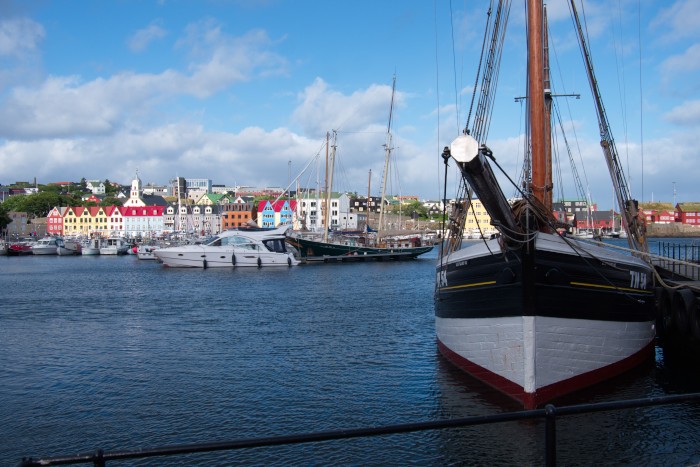
We had a busy day starting with a climb up the very steep slopes of Heimaklettur, the 283m knoll that overlooks the harbour. It is a roosting site for hundreds of puffins and the Icelandic sheep graze the lush grassy upper slopes. We also walked around to the natural amphitheatre where the festival was held under the steep volcanic face of 220m Haha.
After lunch we visited the Eldheimar Volcano Museum. It is built around the excavated remains of one of the 400 homes that were buried by the 1973 eruption. It tells the story, with audio and visual displays, of the trauma of the eruption, the evacuation of the island and the fight to save property and keep the lava flow from blocking the entrance to the harbour. Climbing to the 221m summit of the volcanic crater Eidfell gave us a good view of the lava flow and the havoc it caused. The volcano added 20% to the island's land mass. As with most towns we have visited in Iceland, Heimaey has a great swimming centre with indoor and outdoor heated pools, hot tubs and steam rooms. It was a treat to have a hot soak at the end of the day.
After checking out the weather forecast it was decided to leave after dinner. We fuelled up and departed Heimay at 2300hrs.
3rd - 5th August
Our passage from Iceland to the Faroe Islands was uneventful. We had an ENE breeze for most of the way but not strong enough to push into the lumpy swell without the motor. Midday on the 4th the wind died completely and we motored the last of the 385nm mile passage on a glassy sea. When we arrived at the Faroes their renowned currents picked us up and as we passed between the islands of Stremoy and Vagar we were doing 12.6kts.
In the Vestaranag harbour we found an empty berth in the marina. Torshavn is the capital of the Faroe with a population of around 18,000. There are 18 islands in the Faroe which are part of the Kingdom of Denmark. The islands were settled by Norwegians in the early 9th century but became part of Denmark at the Treaty of Kiel in 1814 after the Napoleonic Wars. Faroese, derived from an old Norse dialect and similar to Icelandic, and Danish are the official languages, but English is also widely spoken. The Faroese also have Gaelic blood in their veins.
Denmark provides 5% of the Faroe income and restricts and controls all their trade. Talking to the skipper of the schooner Nordlysid and his friend, who are staunch Nationalists, it seems that some Faroese would like to sever all ties to Denmark. However, as most Faroese are Danish citizens it is most unlikely that they would break away from Denmark. The population is only 50,000.
They also said that a couple of years ago the EU imposed an embargo on their export of mackerel as they wanted to put a quota on their catch to allow the EU to take more. To balance out this loss the Faroese sold farmed salmon to Russia in contravention to the EU embargo on Russia. One - Nil to the Faroese in the Mackerel war! They also told us that local sheep are for domestic consumption and most restaurant lamb is imported from Iceland and NZ. Here they slaughter their sheep at the end of the summer and leave them to hang for 5 months to produce an air dried meat like biltong. The warmth at the beginning of the process encourages bacteria and they call the end product Skerpikjot or fermented lamb's meat. One of the locals dropped by a sample for us to taste. It was quite gamey to start with, but had the flavour of the remnants of a leg of lamb after sitting in the fridge for a couple of days.
As with Iceland the landscape is devoid of trees as the sheep, introduced by the Celts, ate the small trees and shrubs that existed here. Murray and I had a delicious meal at the Asrstova Restaurant. The entrée was a lobster bisque and for the main course we werTorshavn is amix of old and new with beautifully maintained old buildings around the point of Tinganes, with their turf roofs, and the more modern homes stretching up the hillside behind. Tinganes means Parliament point and the Faroese claim one of the world's oldest having presided here for over a thousand years. The general assembly is known as the "Thing". Ashley suggested that the MPs should be known as "Thingamajigs". The National Museum describes the development of the islands from their volcanic beginnings. In the early times the Faroese were subsistence farmers living on sheep and catching birds for food. At one stage 97% of the Faroese income was from making woollen socks for the King of Denmark which he then on sold to the army and navy. Fishing came later and is now the main source of income today. Most other trade is restricted to passing through Denmark.
After several sunny days, the weather took a turn for the worse with up to 50kts of wind and rain over night, so we took a bus trip up to Bordoy Island to get a perspective of the country. The excellent road network connects most of the islands skirting the coast and crossing the water with bridges or tunnels under the sea. Small farms line the steep green valleys and fishing ports dot the coast. There are hiking trails all over the island and is a paradise for bird watchers. The weather was wet and windy with a strong NWer gusting to 50kts.
e presented with a delicious slow cooked whole shoulder of a lamb. Between us we ate every skerrick of melt in the mouth meat to the bone. Afterward there was no room for dessert. Cooking instructions for shoulder: 20 minutes at 210 degrees then 2 hours at 120 degrees followed by at least 4 hours at 80 degrees.
6 August
Torshavn is a mix of old and new with beautifully maintained old buildings around the point of Tinganes, with their turf roofs, and the more modern homes stretching up the hillside behind. Tinganes means Parliament point and the Faroese claim one of the world's oldest having presided here for over a thousand years. The general assembly is known as the "Thing". Ashley suggested that the MPs should be known as "Thingamajigs". The National Museum describes the development of the islands from their volcanic beginnings. In the early times the Faroese were subsistence farmers living on sheep and catching birds for food. At one stage 97% of the Faroese income was from making woollen socks for the King of Denmark which he then on sold to the army and navy. Fishing came later and is now the main source of income today. Most other trade is restricted to passing through Denmark.
After several sunny days, the weather took a turn for the worse with up to 50kts of wind and rain over night, so we took a bus trip up to Bordoy Island to get a perspective of the country. The excellent road network connects most of the islands skirting the coast and crossing the water with bridges or tunnels under the sea. Small farms line the steep green valleys and fishing ports dot the coast. There are hiking trails all over the island and is a paradise for bird watchers. The weather was wet and windy with a strong NWer gusting to 50kts.
Reykjavik to Vestmannaeyjar Islands - Iceland
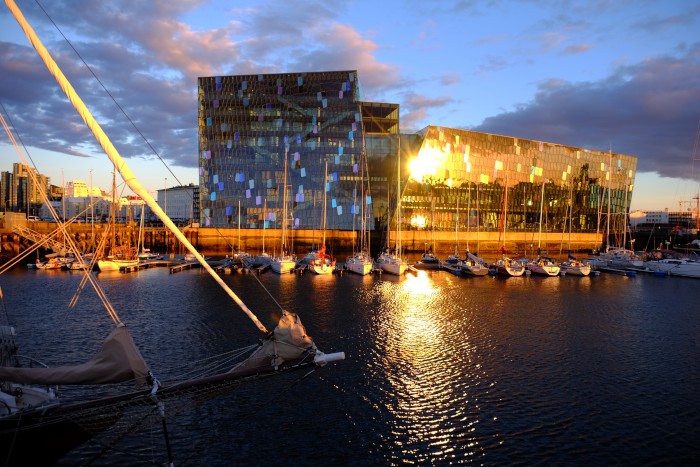
1st August After departing Sandgerdi at 0600hrs we were amazed to see an iceberg shining white on the horizon, but eventually we found it to be a large guano covered iceberg shaped rock! Our destination is the Vestmannaeyar Islands, a group of small volcanic islands 5 - 10nm off the coast of Iceland. They are named after Irish thralls (slaves) who were killed for murdering one of the original Norse settlers in 874. The most recently created island is Surtsey which popped up after an underwater eruption in 1963. The only inhabited island is Heimaey where in 1973 an eruption produced a new conical mountain, wiped out part of the town and improved the harbour by blocking off half of the entrance.
Patreksfjordur to Reykjavic - Iceland
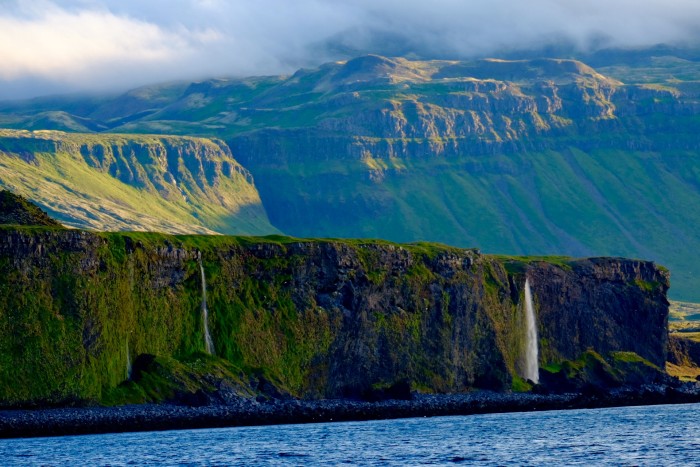
26th July An early start. Away from Grundarfjordur by 0500hrs. We sailed with a light NE breeze around the Snaefellsnes Peninsular and anchored outside the timy harbour at Arnastapi. It was a beautiful clear afternoon as we walked around the coast from Arnastapi to Hellnar. Interestinmg volcanic rock formations provide many homes for nesting birds. The country slopes steeply up to the snow and ice capped Snaefellsjokull. 27th July Sailed with clear skies to Reykjavik arriving at 1600hrs. Tied up at the Brokey Reykjavik Yacht Club marina which is centrally located and overlooked by the spectacular Harpa concert hall.
28th - 29th July Reykjavik The city has over half of Iceland's 320,000 population living in it and is a modern busy centre. A mix of tall new buildings and older, mostly corrugated iron, dwellings, the centre caters to a flood of tourists in summer. There are numerous bars and restaurants and shops selling souvenirs, especially knitted woollen jumpers. A steady stream of cruise ships offloads into the city and it has a busy airport at Keflavik about 40kms away. Food and drinks are good, especially the icecream, but everything is very expensive. All the people we met spoke good English and the locals are helpful and friendly. (Fixed chipped tooth and cracked iPhone.)
30th July It is a public holiday and Reykjavik was deserted. We hired a car and drove around the tourist route known as the "Golden Circle". This route is followed by all the tour buses so we had plenty of company! Our luck with fine weather continued and it was very calm which is apparently rare. It soon became apparent where all the Icelanders were as all the campgrounds were full. There are hiking trails all through this part of the country and the Icelanders seem to be a fit, slim, outdoor loving mob. Our first stop was at Pingvellir. Geologically this is where the European and American continental plates meet and are separating at 2cms a year. On the surface this shows as a rift in the rocky terrain. The narrow gorge formed by the rift is of a major significance historically. In early times the settlers, who arrived from Norway in the late 9th century, gathered here annually. They came from all over the country to pass laws and adjudicate disputes and it was here they formed their first Alpingi or Parliament in 930. Since then Icelanders have gathered here for significant occasions. In 1930 when Iceland was a sovereign state under the King of Denmark thousands gathered to mark the millennium of the foundation of the Alpingi and in June 1944 for the foundation of the modern Republic of Iceland. The geothermal activity is very noticeable in this part of the country with steaming vents dotting the countryside. There are clusters of small bungalows with their own hot pools. Over 99% of Iceland's power is generated by geothermal or hydro power stations. Our next stop was at Geysir which lent its name to all the Geysers in the world. This geothermal field has many pools bubbling away and one geyser that spouts 15-20m into the air every few minutes. We had a picnic lunch on the cliffs above the Hvita River and then drove upstream a short distance to the spectacular Gullfoss falls. This was as far north as we could drive in our 2 wheel drive car as we were in sight of the Langjukull icecap which covers a large part of the centre of Iceland. As we headed south towards the coast the valleys widened out into farm country with hay making, sheep, cattle and horses. Apparently, the Icelandic horses are a pure strain bred from the original imported from Norway and their bloodline is strictly controlled. They reportedly have a fifth gait which makes for a very comfortable ride. The lower country also grows grain crops and greenhouses produce mushrooms and tomatoes. At the coastal port of Portakshofn we turned north past Hveragerdi with its geothermal park and over the lava fields to Reykjavik.
Isafjordur to Patreksfjordur - Iceland
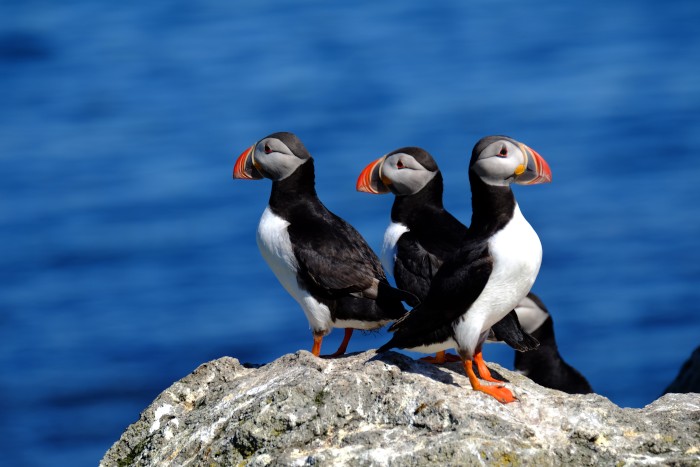
Isafjordur
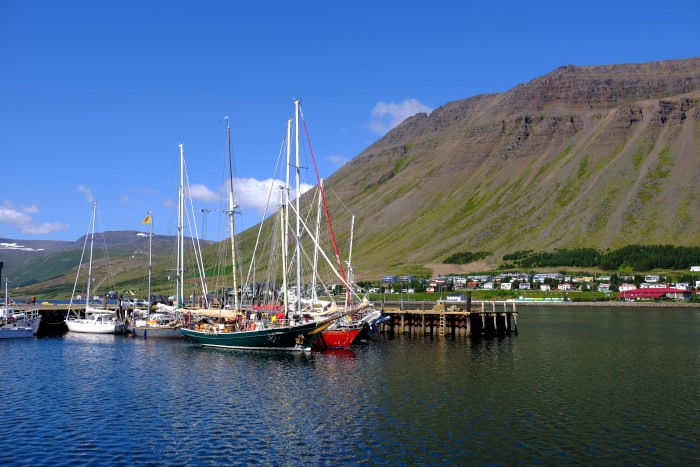
Passage from Greenland to Iceland
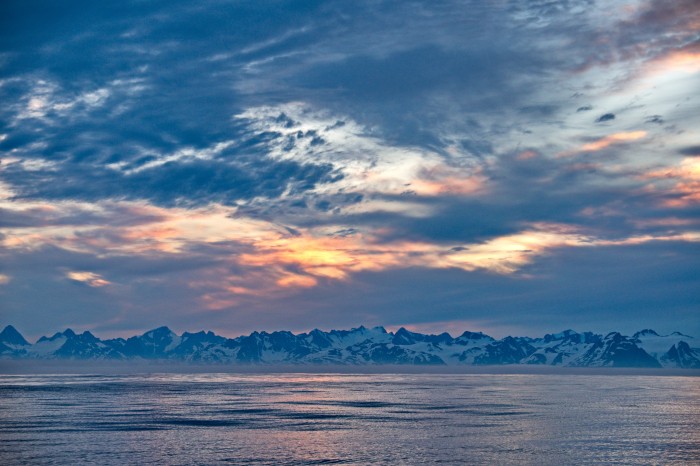
Qutdleq - Sermiligac - East Coast of Greenland
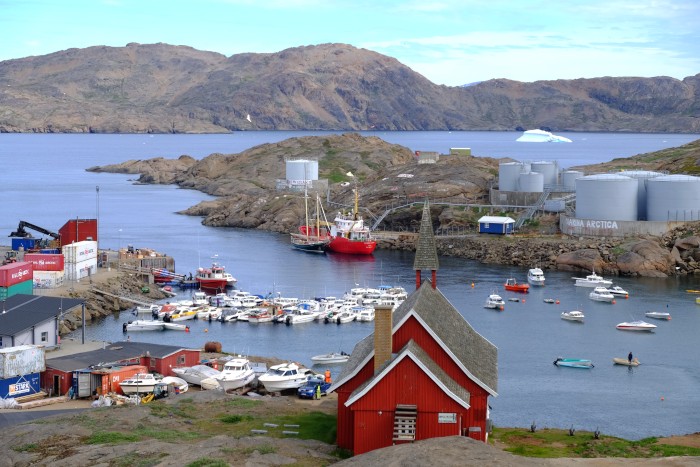
Prins Christian Sund - South Coast Greenland
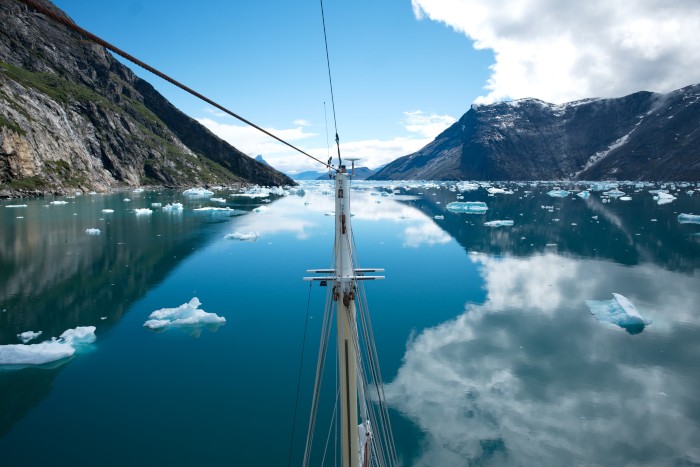
7th July - We spent the morning in Nanortalik visiting the lovely historical old part of town and catching up with Wi-Fi at the tourist office. The oldest stone buildings date back to the 1820s and are in excellent condition. In the afternoon we motored to Torssuqataq Sound, as usual, dodging icebergs along the way and anchored in Paakitsuarssuaq, a wonderful peaceful cove nestled in amongst the rounded 800m granite hills.
8th July - We had a wonderful day with clear sunny skies and very little wind. Leaving our anchorage we motored along Torssuqaataq. This fjord is lined with tall granite cliffs which reflect in the calm waters. This area has become popular with rock climbers who tackle the "Baron" Spire (1,340m), the 600m wall of the "Baroness" and the "Thumbnail", a 1,460m cliff rising straight up from the sea. We pulled into a small fishing village, Aappilattoq, its entrance just a cleft in the rock and the town hemmed in by the soaring peaks behind. The population of around 100 people fish and hunt seals from small boats. Ashley met a family celebrating their child's 1st birthday and invited in to their home for tea and cakes. The grand father showed him the skull of a polar bear the he. had shot recently near the village. He said it was the 3rd polar bear he had shot and they all enjoyed eating the meat. We also met fishermen returning with a catch of the local halibut and a seal.Continuing on along Prins Christian Sund we passed numerous waterfalls cascading hundreds of metres down from glaciers and ice caps above. Some of the glaciers come down to the waters edge. At Sermerunerit Glacier Ashley, Murray and Maggie hopped in the dinghy and took some fabulous photos of Windjammer up against the ice face. Further along we passed the wide Svardfisken Glacier with dark streaks of debris highlighting its march down the valley. Seals keep a low profile in these waters because they are hunted, but we did spot a large "Bearded Seal" relaxing on a bergy bit.
Nearing the entrance to Ikerasassuaq (Prins Christian Sund) we pulled into the small dock at the Ikerasassuaq radio and weather station. There was a little surge coming in, but we had a comfortable night with a breast line taken across to an adjoining rock. For dinner we enjoyed the last of the mussels from Kapisillit which have been treated to a change of sea water every day and kept happy.
9th July - The grey drizzly morning emphasised how lucky we were yesterday to experience such a clear day in the Sound. We climbed up 270 stairs to the weather station, which although unmanned and totally locked up, is fully operational and remotely operated. When the station was still manned, there were dogs kept as an early warning system for polar bears. The staff must have had a lot of time on their hands as we noticed a TV antenna on one of the kennels and an ash tray half way up the steep steps. When Ashley had manoeuvred Windjammer out of the very tight harbour we motored into a fresh NE wind with low clouds, rain and a choppy sea. The day steadily improved giving us the first views of the east coast and some huge icebergs grounded along the way.
Fortunately, there are not many growlers about so we were able to stand solo watches in the chilly breeze. Mid-afternoon we pulled into Kangerdlarajik Fjord and dropped anchor in Peersvig Bay. Ashley ranked this as one of his top anchorages in the world. An open bay with the shore sweeping up to high snow-capped peaks and numerous glacier filled valleys that disgorge ice into the fjord. Nearby a torrent of glacier water cascaded into the bay. As we clambered up its course to the lake 300m above the bay. Blue sky's opened up from the east and we had a wonderful view over the fjord with the soft evening sunlight highlighting the the surrounding snow capped mountains. "Mona", the motor yacht we'd last seen at Nanortalik was also anchored in the bay.
10th July - A fine sunny day with little wind as we continued motoring up the East Coast. This coast is quite different to the West Coast. There is no hint of greenery here, but bare weathered and scoured rock where the snow and ice have melted near the sea. Glaciers stretch down to the ocean and the icecap stretches up into the distant horizon with only occasional peaks penetrating the frozen white mantle. This is a very harsh, desolate and almost overwhelming piece of coastline. Everyone took advantage of the glorious conditions to do some washing and airing of clothes with hardly any unused space on the lifelines. We watched as wisps of lenticular clouds played around some of the coastal peaks and we were occasionally temped to set some sail, but the calm conditions continued throughout the day. It was very pleasant taking a nap on deck in the relatively warm sun as the low swell rolled under the boat. We spotted seals and whales in the sea during the day, but they all appear very timid. In the evening we anchored in a sheltered bay on the island of Qutdleq. There are remains of a Loran C station here that was abandoned in 1973. Loran C was a terrestrial navigation system used before the advent of satellite systems. Establishing a station here would have been quite a challenge. Onshore there was a landing, a big fuel tank, a boat house, a bitumen road and the remains of the pylons for the conveyancing system used to lift all the building materials and supplies up to the main station above. We came across a large set polar bear foot prints in the snow as well as a smaller cub set. This created some anxiety for us as Murray had left us for a climb up the steep hill behind the anchorage to check out the top station. This was the first time we had ever separated but the visibility was so clear allowing a good all round view. His return was a relief and much quicker, sliding down the snow slope at speed albeit oblivious to the threat of a lurking polar bear.
Nuuk Fjords and heading south - West Greenland
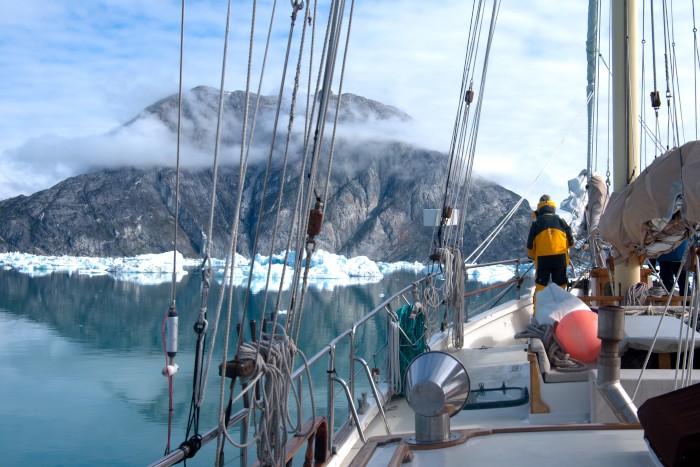
Nuuk Isfiords - Greenland
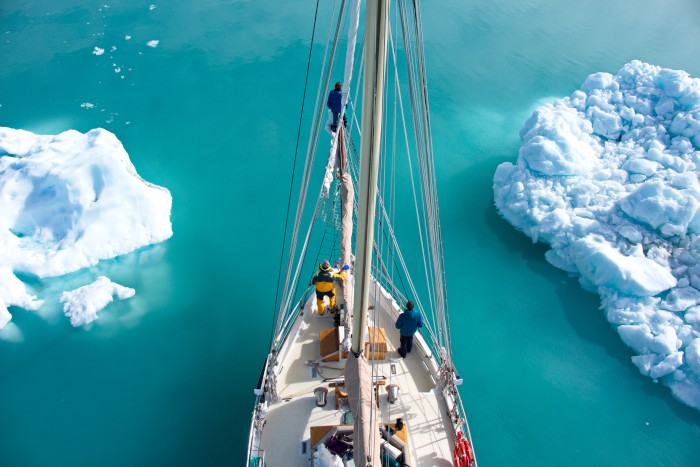
Our original intention was to continue north to Disco Bay but the ice charts indicated that there was still significant ice in the bay. A chance visit to the Nuuk Yacht Club revealed that one of the hidden treasure of Greenland "Isfjord" was tantalisingly close by. A network of fiords and glaciers was a favourite cruising ground for locals in the know, but overlooked by cruising yachts bound for Disco Bay or the North West passage. So armed with mud maps and recommended secret anchorages we set off to explore.
June and a clear cloudless blue sky gave us a wonderful appreciation of the majestic scenery as we weaved our way through the still waters towards the Ihilialik Glacier. The ice became harder to navigate as we approached the glacier and eventually we were stopped by it. Before turning back we watched a couple of Humpback whales as they blew on the surface before sounding. With the motor off we enjoyed the sounds of the whale's breath and the cracks, hisses and occasional whooshes as pieces break off the bergs and slide into the sea. There was a lot of ice in the water which made it slow going as we piloted our way back past the shaved faces of the rocky peaks lining the fjord. One granite outcrop rising sheer from the water looked like a chimney with the smoky clouds billowing out. It showed on the chart as being 1,220m high. In the mid-afternoon we arrived at Kapisillit, which means "the salmon", and we anchored near the mouth of a stream where the salmon spawn. Supposedly this is the only salmon run in Greenland. The town is very neat with some short sections of paved road along which there are regularly placed bench seats. As there are less than 100 locals living here we suspect that there is about one bench seat per person. There is also street lighting and a huge fuel storage tank. Ashley and Maggie caught loads of cod and Matt caught his first ever fish here, but not before losing his fishing gear over the side. Luckily he was able to retrieve it. One huge cod Ashley caught weighed over 15kg. No salmon were spied. We had our first encounter with Greenlandic insects and the head nets we purchased in Newfoundland were put to good use.
Fashion at the Floe: There have been some comments passed around regarding the 3 Tele-Tubbies with Matt, Murray and Nick wrapped in their blue, red and yellow outfits. Though no one compared to Ashley this morning, elegantly suited in orange jacket with matching fluorescent orange fisherman's gloves that matched the orange logo on his caps.
1st July - A crystal clear morning encouraged Ashley, Cathie, Matt and Maggie to walk over the hill to view the Kangersuneq Isfjord packed solid with ice. On their return we gathered a bucket of mussels from the beach and as we up anchored and motored along Cathie created a delicious mussel and fish soup. Not a cloud in the sky as we cruised through impressive fjords to Qooqqut.
Fashion ON the floe: Mid-afternoon, with a towering granite backdrop and sparkling seas we enjoyed another fashion treat. Matt (ice tester), Ashley (model) and Maggie (photographer) boarded a submarine shaped iceberg. With professional panache our model soon appeared in his trendy briefs (jocks) with straw hat, umbrella and crampon equipped Ugg boots. Paris eat your heart out! Matt, not to be outdone, stripped down too and rolled on the ice - proving that old ice is hard ice by skinning his elbows. In the evening we dined ashore at a quaint restaurant at Qooqqut Nuan catering mainly to the Nuuk day trippers arriving in small motor boats. We enjoyed a meal that included Musk Ox, lamb chops (NZ), scallops, prawns, shrimp, red fish and cod. Our excellent young waiter, Joorut, mixed us a Greenlandic coffee to finish the night! Irish whiskey - representing the man, Kalua - representing the woman, coffee - representing the arctic night, cream - the arctic snow and flaming Grand Marnier - the northern lights. Joorut also told us that anyone can apply for a permit to build a cabin along the fjords and that if the regional office approves the permit there is no cost or ongoing fees to use the land.
Nuuk - Greenland
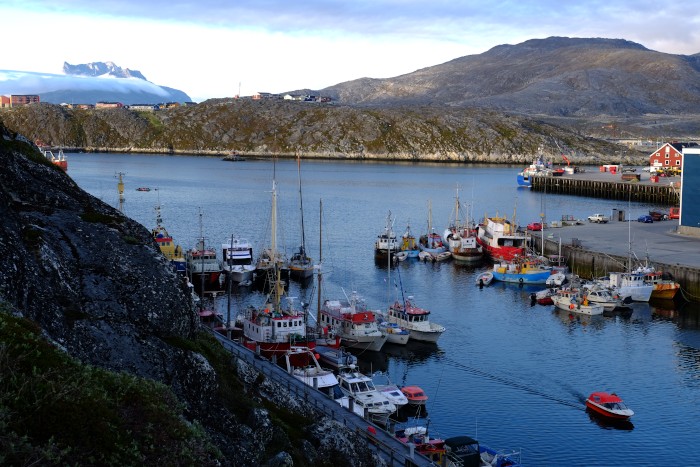
"Eskimos and the Igloos" - Maggie reflecting on the present day Inuit communities we have been privileged to experience.
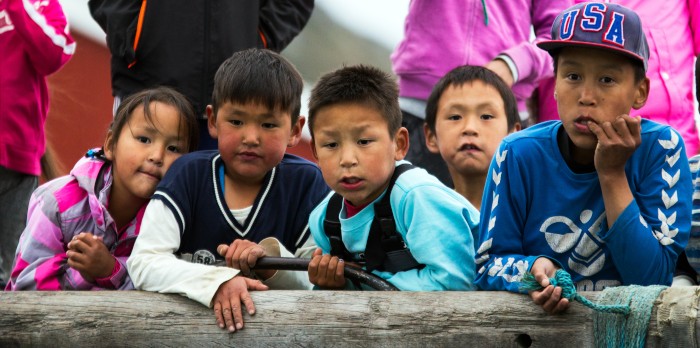
Have you ever heard storieis, the stories of Eskimos living in ice Igloo's? Well, the term 'Eskimo' is a European derogatory connotation of all people native to the Arctic. In Greenland, the native people are more accurately known as Inuit, which translates to 'The People'. The inuit were very resourceful people and used what the land offered to build their homes, unfortunately this was limited to stone and ice. In the summer months, small communities lived together in small houses made of stone but the winter required more warmth in the bitterly cold climate. A home built from Ice may not appear to be effective, however by insulating the interior with animal skins, it effectively provided a warm environment. Their clothing design cleverly mimicked a polar bears coat, comprising of skin and fur predominately from birds, musk ox, seals and bears.
Since the Danish inhabited the island in 1728, the Inuit still stand true to old traditions, which has fundamentally shaped modern Greenlandic society. Hunting was an essential part of inuit life and necessary for survival on their land. With the belief that everything in nature has a soul spirit, they recognise a relationship between human and nature. They believe in living in mutual respect to ultimately maintain the balance of the world. If they were a good person, with a clear conscience, an animal would offer themselves to be killed, thus maintaining the cycle of life. If the hunter did not have respect, he threatened to disorder sea and land as well as birth and death; the relationship between humans and nature.
Too often Westerners have judged the inuits for their way of life. They have been called 'savages' yet their ways have outsmarted Western culture for centuries. They have been criticised because they hunt the mammals that we have grown to love so deeply. Although, what we have been so ignorant to see is that they hunt purely to survive on this land, just as the polar bear hunts the seal and the seal hunts the salmon. They do not kill for profit but to provide food for their family. When the hunter returns home with his kill, he calls the family to come and share the food for their stomachs, the skin for their warmth and the bones for their tools. The entire community comes, because to an Inuit, family is everyone by association. How can Western society be so quick to judge these intelligent, resourceful, humble and honest people when our culture is ignorantly damaging our natural world beyond repair. The Inuit have such an undeniable respect for nature and all its beings, the same cant be said for the Western culture driven by such greed.
As history writes itself, the influence of European culture is impacting on the indigenous people in ways we have seen too often across the world. The introduction of alcohol has troubled communities and the dependance on this foreign good is unsettling. Naturally, the government has enforced strict quotas restricting the natives ability to hunt, a tradition that not only depicts their lifestyle but represents the essence of their culture. There lives have been turned upside down by the Danish, they have been forced to adapt to a new way of life. For that, the government heavily supports the native people, so much so that most have become solely dependant on the welfare system. Regardless of the desire to thrive on employment and gain independence, the lack of employment opportunities has founded the expectation of financial support which has become a fundamental part of their new way of life.
Great new adventures and great new seas
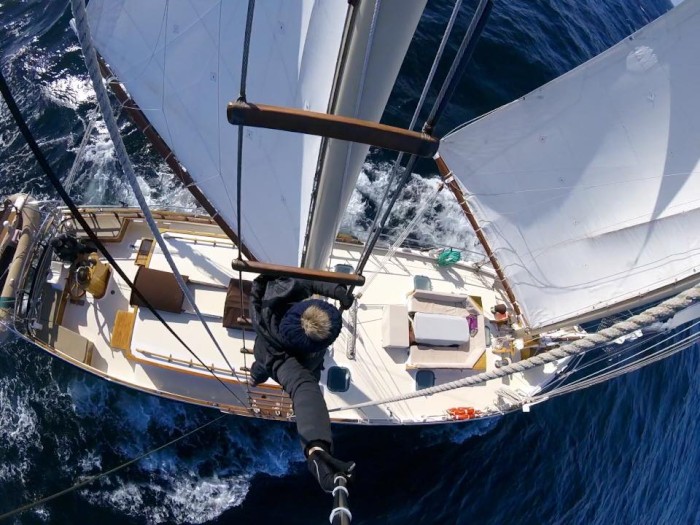
You lose track of time, days and worries as you become completely immersed in this newfound reality. You ponder the journey the whales are on as they gracefully skim the ocean surface and admire the birds as the joyfully ride the wind that has taken them so far from land. The days do not begin, nor do they end. The sun sets in the North and lingers on the horizon while the moon rises in the south. The sky is luminous all day and all night for the arctic summer holds onto its light. Our days are not filled with expectation, but the freedom to just be. We sailed, we dreamt and we laughed, for our four day passage was so pleasant that if it was not Greenland we were approaching, the idea landfall would have been far less attractive.
We hit the western coast of greenland early evening and with a crisp fresh bight to air. The vibrant orange tones from the sun struck through the heavy low clouds and the fog rolled out revealing the land. The charming Norwegian style houses along the entrance of the harbour were a welcoming sight as we approached the capital city of Nuuk. Fireworks from the town took to the sky and we marvelled in the idea that Greenland was a country that none of us had ever thought we would one day explore. By dawn we had snuck in and tied up to a row of boats on one of the many jetty's packed with small powerboats, careful not to disturb the quiet and stillness of the colourful harbour. Windjammers crew slept soundly, yet with great anticipation as the morning would bring the opportunity to climb across the neighbouring boats to find out if Greenland really is green.
Marys Harbour, Labrador to Nuuk Greenland
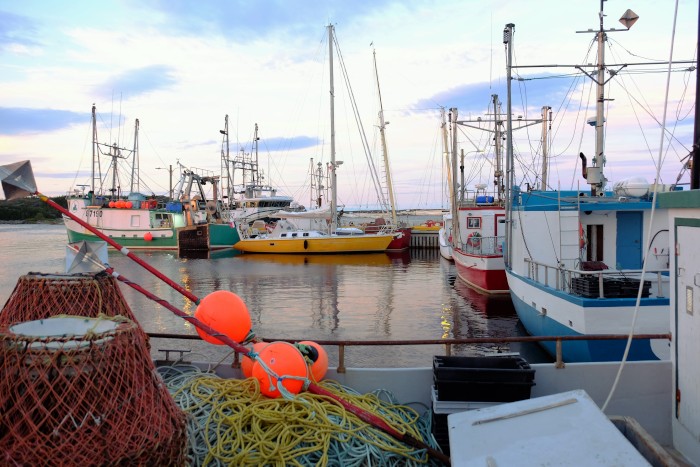
Davis Strait
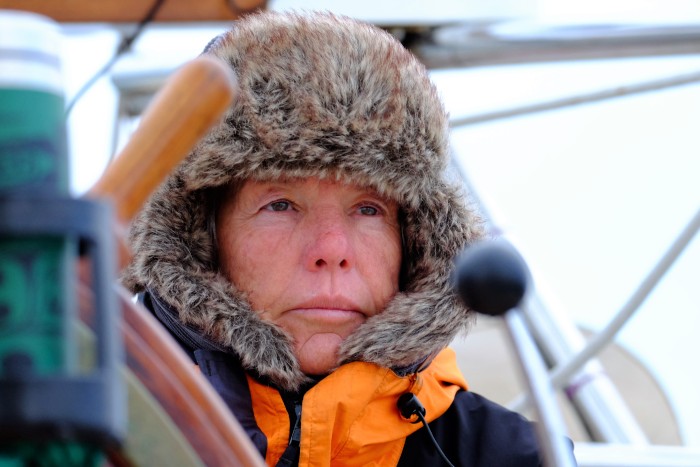
24th June A light breeze from the SE came in this morning and we motor sailed until it filled in around lunch time. Set Fisherman. We have not seen any ice for a day and as we clear the cold Labrador Current and enter the Davis Strait the water temperature has risen from 3° C to 10° C. Ashley worked on the heater for several hours and seems to have found the problem causing the irregular burning. Looks like the spring valve in the regulator may have been incorrectly replaced. Much better burning now. Made steady progress under sail through the day and with 324nm to Nuuk we are over half way there.
St Marys Harbour and departure for Greenland

St Anthony to Marys Harbour - Newfoundland.
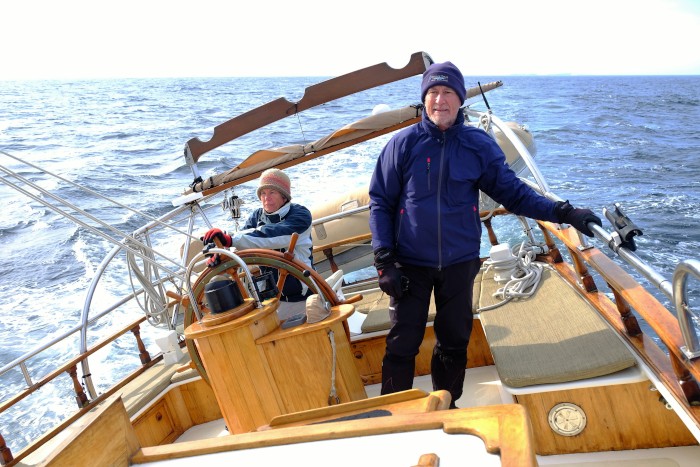
St Johns - Newfoundland
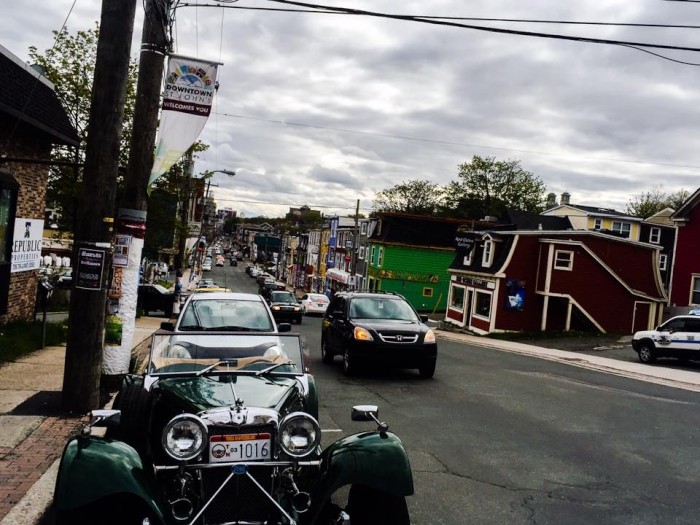
I spent the following day hiking the dramatic coastline to Signal Hill, the easternmost point of North America, where Gugiemo Marconi flew a kite in a gale to receive the first ever transatlantic wireless signal in 1901. It was a significant scientific breakthrough that drastically improved the safety of ships crossing the North Atlantic ocean to and from Europe.
St John's offered us the opportunity to restock provisions and purchase some warmer gear, however we were ready to escape the hustle and bustle of city life and head further north, to one of the oldest towns in Newfoundland; Boavista.
Departing the harbour in the dusk of the following morning, had us surrounded by dense fog with the sound of the lighthouse foghorn blasting in the distance. The presence of fog is a common navigational hazard in the North Atlantic, the notorious southwesterly winds pick up moisture from the warmer waters of the gulf stream and carry it over the much cooler waters in the Labrador current. The contrasting temperatures being brought together, react and create fog. It becomes disorientating, mysterious and dangerous when navigating through fog in such unpredictable ice ridden waters.
Lumsden Harbour to St Anthony - Newfoundland
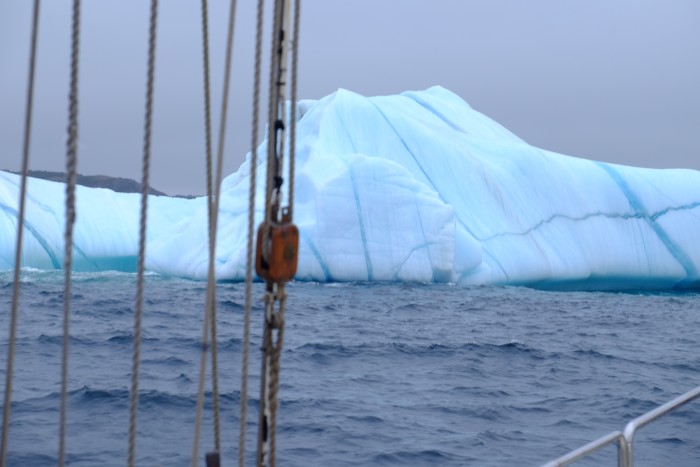
Bonavista - Newfoundland
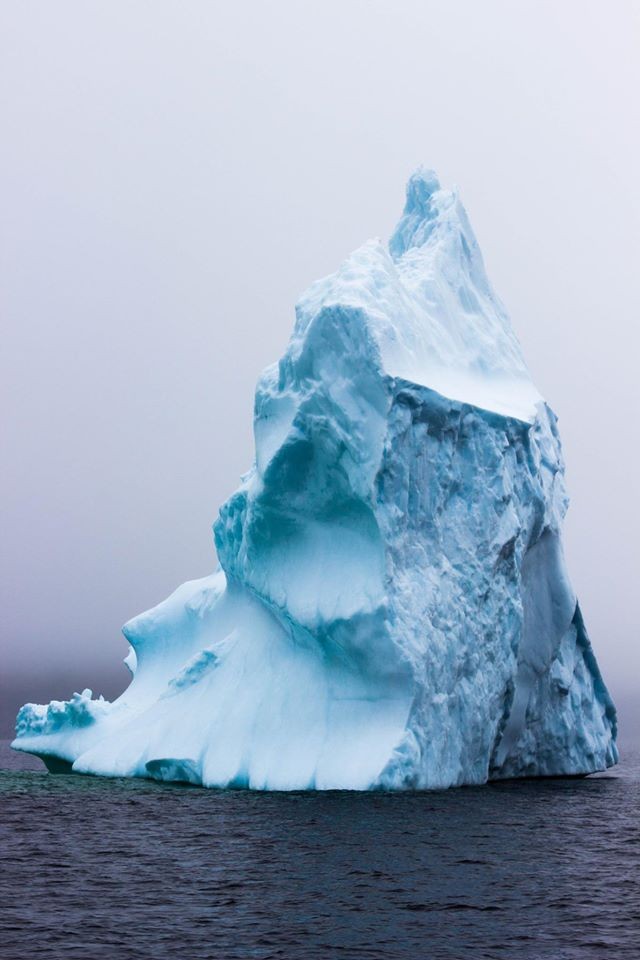
I spent the day soaking up the history of Newfoundland which all began in this quaint little fishing community. The North Atlantic is rich in fishing history, predominantly cod fish, which the Newfie's refer to only as 'fish' and everything in the ocean as 'everything else.' Captain John Cabot discovered the eastern coastline of Newfoundland in 1497. He had hoped to discover a passage to Asia, however, returned to England with news of New found land that was highly overpopulated with fish. It wasn't long before the English, French, Spanish and Portuguese came annually to fish the waters and permanent settlement of Newfoundland was established. Cod ruled the fishing industry, it consumed the lives of Newfoundlanders and wars were fought over it. By the 1900's, the impact of commercial fishing caused such a significant decline in fish stocks, that the atlantic commercial fishing industry nearly collapsed. The federal government had no choice but to impose a moratoriam, putting an end to over 500 years of northern atlantic cod fishing and in turn, over 40,000 jobs. The practice of overfishing shaped the lives and communities of Newfoundlanders because after all, it is known as the land of cod and as the cod became scarce, so did the communities.
Over 40,000 icebergs break away form glaciers in Greenland and Baffin Island each year, the Labrador current draws them south along the east coast of Newfoundland to what is known as Iceberg Alley. Departing Boavista at dusk, we headed north and officially entered the notorious Iceberg Alley. In the Northern Atlantic, ice is the dominating navigational hazard, it is unpredictable and often unstable. What is most daunting is that only one 1/8th of the iceberg is visible above the surface. Consider dropping an ice cube into a glass of water, majority of the ice sits below the waterline. But now put that in perspective, that ice cube is on average 30m high and 204K tonnes, this is what we are up against. However, it is not necessarily the initial iceberg, known as a 'growler' that proves to be the hazard as they are generally picked up by the radar. The ice that breaks away from the berg, known as 'bergy bits' are what are most dangerous to cruising yachts as they are difficult to see and often can be mistaken for white wash. Navigation through fog and at night seriously reduces visibility and requires two crew members communicating wth each other on watch at all times. One crew at the bow keeping watch for ice and one at the helm ready to alter course in order to efficiently dodge any ice. Although the crew have experience navigating in iceberg frequented waters in the Southern latitudes, the north does not even begin to compare. With a significantly higher concentration of ice, iceberg alley officially introduced us to ice navigation in the North Atlantic.
St Johns to Lumsden - Newfoundland
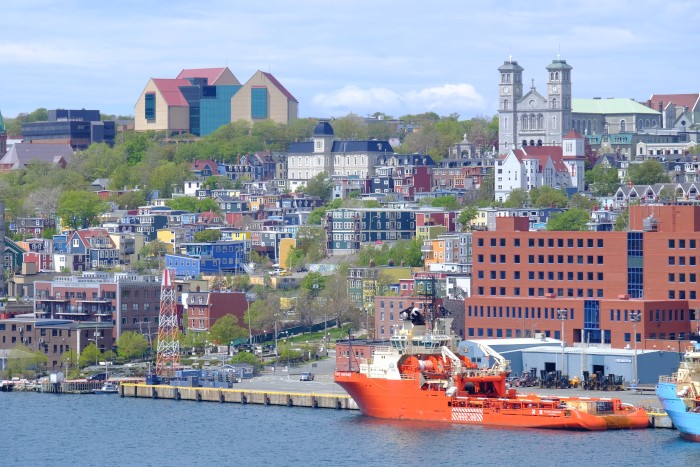
St Pierre to St Johns
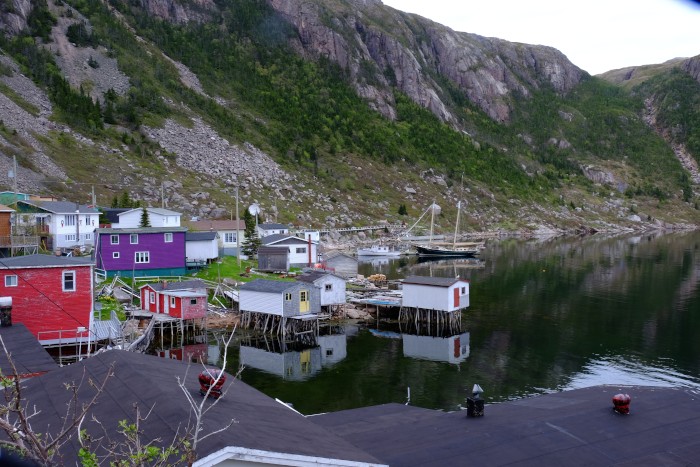
Where France meets North America
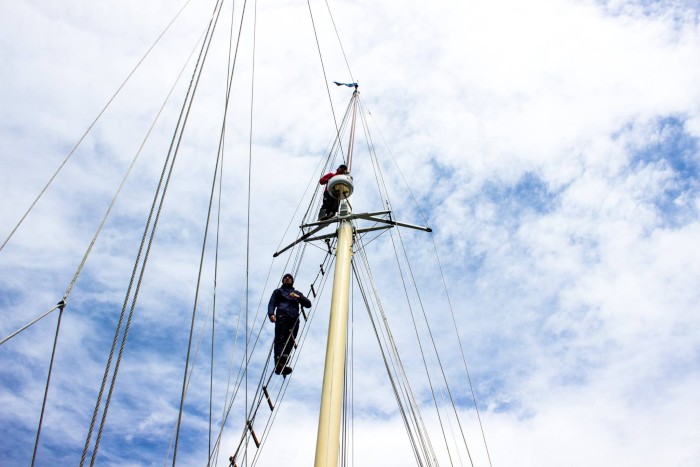
Windjammer's cellar had been cleaned out for the opportunity to refuel with France's best. And so, over 100L of red wine and rum were eagerly sourced and stowed; in hope of satisfying six thirsty sailors for 3 mo
Threats of gale force winds caused us to delay our departure from St Pierre, putting us slightly behind schedule for our Arctic adventure. We spent the day making use of the yacht clubs showers and internet before we cast off the lines early the following morning, and said a final farewell to this delightful french island.
St Johns was our next destination, a two day passage north along the east coast of Newfound to the provinces capital. With unfavourable wind conditions and minimal breeze, the sound of the engine roared through the wooden floorboards as we stood our watches through thick lingering fog. Huge swells sent Windjammer rolling though the waves forcing the crew to quickly adjust to the unstable conditions. Late afternoon the wind came around and the great King Neptune finally answered our prayers. The sail covers came off, the three glorious white sails were hauled and the roar of the engine was finally no more. There was wind in the sails and a firm grip on the charming wooden helm as we sailed through the night. The fog cleared by morning and the weather was kinder, allowing us to shed a couple of layers and move more easily about the boat. Now that we were sailing, the uncomfortable and unstable rolling soon transitioned to a pleasant and soothing motion. With the help of the heater, the more favourable conditions were sending the crew into a sleepy trance whilst they waited to be called up to their watch.
Newfoundland
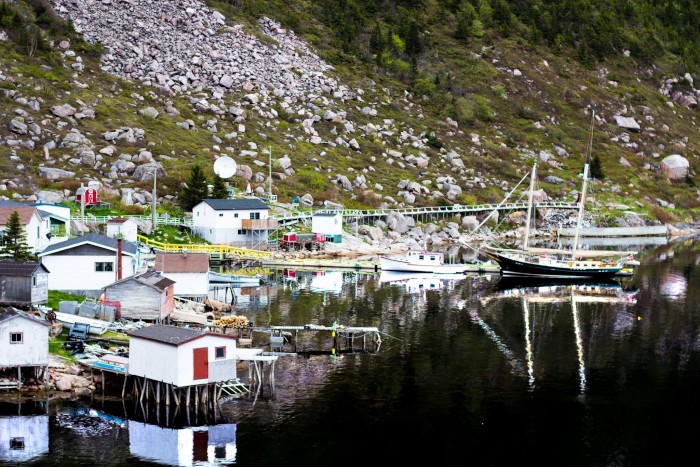
Our crew comprise of six salty sea dogs of whom are well accustomed to sailing on Windjammer. Ashley & Cathie are the captain and wife who set sail from Australia six years ago, Matt crossed part of the pacific with them and Murray, Nick and myself were apart of their adventure to Antarctica.
Our journey begins on the west coast of North America where we will sail through Newfoundland as far as Labrador before crossing the Davis straight to Greenland. We will continue to sail north on the western coast of Greenland to enter the arctic circle then return to round the south tip of Greenland and cross the Denmark straight to Iceland. From there, I will sadly say farewell and return to Australia, while the crew continue to circumnavigate Iceland and then sail to Norway.
Newfoundland is like a little lost piece of the world that people seem to forget exists. The communities are small, the words are few but the fiddle always plays its tune. Our first night aboard was an overnight passage to the Ramea Islands where we pulled into the small fishing village in the town of Ramea. The town is home to around 150 people, two small grocery stores and one restaurant that closes for months at a time. We tied up alongside a fishing boat and watched as the men sung sea shanties and guzzled beers mid morning while offloading thousands of live scallops. We learnt the trade of shucking scallops and indulged in the rewards of our hard work for dinner that evening. We continued to explore the northwest arm of Grey River and landed at Deadman's cove where we hiked a 350m high mountain with smooth rock faces overlooking a spectacular fjord carved by glaciers.
The next stop was Francois, a small fishing village on the banks of a sheltered inlet on the mainland. With no local pub in town, the 'Newfie' locals make do with a shed on the waterfront. We were invited to join them while they played music, drank and danced to their hearts desire. Although we may have not been able to fully comprehend the speech through the thick Newfoundlander accent, their welcoming nature and love of music won us over.
The weather has been charming us by showing off its glorious sun beaming through clear blue skies and not a breath of wind to disrupt the crystal glass water surrounding us. We have been watching dolphins play in picturesque sunsets and whales skimming the surface. Yet the crew would not be the sailors they are if they were not craving wind to pull the lines that would have the big white sails gloriously billowing in a steady breeze.
South Coast of Newfoundland to St Pierre

Sydney Nova Scotia to south coast of Newfoundland
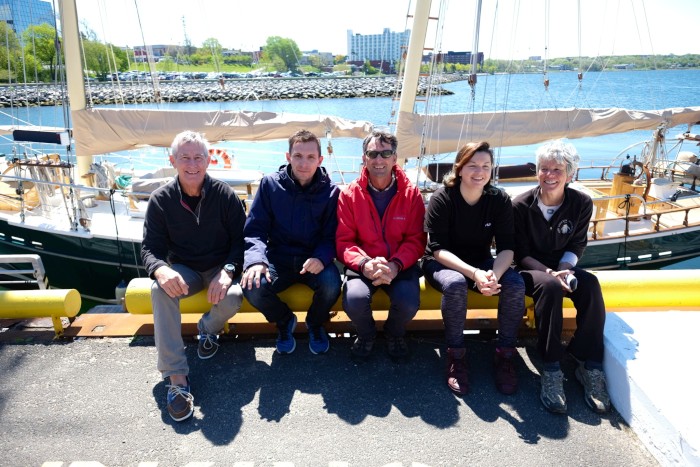
Sailing to Nova Scotia
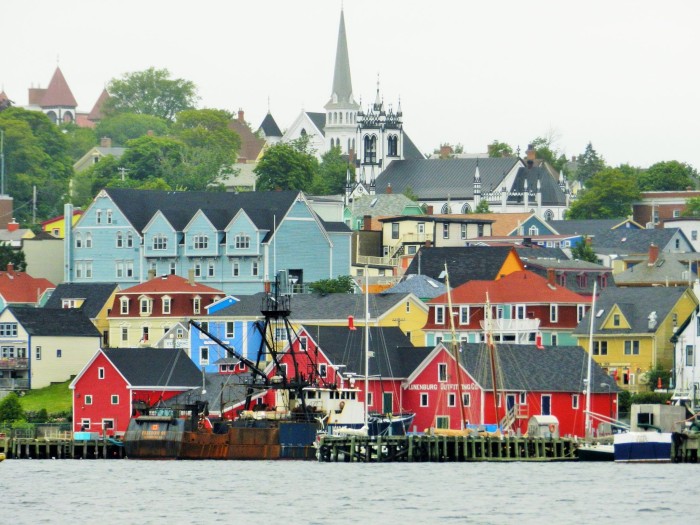
We left the dock at 6 am on Sunday, thanks to Mike for helping us with the lines, and motored all the way in the rain to Onset Town at the southern entrance to Cape Cod Canal. A good work out for the new foulies. Must give Gill a bit of a plug here, they gave me a complete new set to replace the previous ones that were just starting to leak even though they were 5 years old and done 55K miles. They provide life time warranty on their gear.
Back to Onset, this town is noted for having the best Pizza Joint in Cape Cod "Marc Antonio's" and for offering a safe anchorage for boats waiting for the tide to transit the canal. Beer and Pizza with an early night set us up for our 5am transit of the canal next morning, hooking in to a brisk 4kn tide.
After "popping" out of the canal, sails were set, fortunately without a hitch, though it did require several "umm is this the one" after our six month winter layup. The heater is working a treat but we do have to gybe the flue first before we gybe the sails to ensure clear airflow over the chimney.
A little dove landed on the foredeck this morning then took off again looking quite lost, lots of Northern Fulmars and little shearwaters flying around us sporting their new summer plumage.
Our expected arrival in Lunenburg is tomorrow morning (Tuesday).
Arctic Circle passage
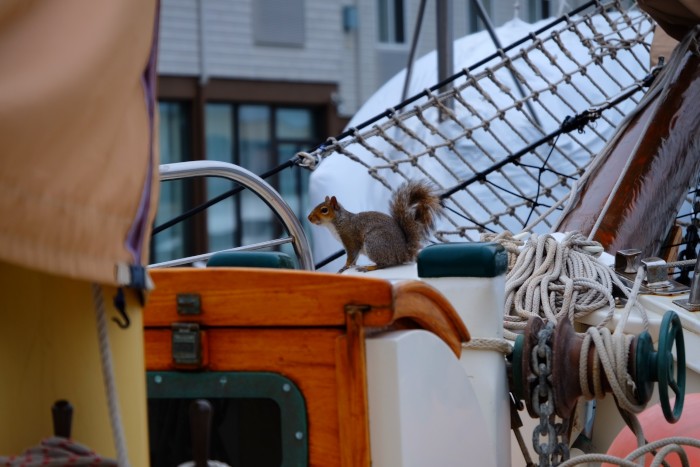
It will be sad to say goodbye to Newport and all the friends we have made here during the winter. As it turned out it was quite a short winter for us due to the 7 weeks spent in Australia and the road trip to Quebec. We did however manage to complete our project "wish list"... painting and varnishing the internals and non skid deck. Cathie made new cockpit cushions and some new covers while I did the engine maintenance stuff... heat exchangers, injectors, water pumps etc. On the big spend side we had to replace all the Lifeline AGM batteries, liferaft and anchor chain. We also completed our Ham Radio licence, something we have been wanting to do for some time.
.png)
We built a frame over the boat, then shrink wrapped it. A few clears for windows, a wooden door and a chimney turned Windjammer into a very cosy igloo.


About & Links
- CUBA 2015;
- SCANDAVIA AND BALTIC SEA 2016; Norway, Denmark, North Germany, Ijsslemeer
- INDIAN OCEAN 2020-21; Seychelles, Tanzania, Chagos, Maldives
- RED SEA 2019; Egypt, Jordan, Sudan, Eritrea, Djibouti, Socotra
- AROUND BRITAIN & IRELAND 2017
- MEDITERRANEAN ODYSSEY 2018-19
- NETHERLANDS 2016-17; Winter in Amsterdam, Stande Mast canal to Belgium, English Channel to London
- ARCTIC ADVENTURE 2016; Nova Scotia, Newfoundland, Greenland, Iceland, Faroes, Shetlands
- US EAST COAST & NOVA SCOTIA 2015;
- CARIBBEAN 2015
- SOUTH ATLANTIC CROSSING - USHUAIA TO CAPE TOWN 2014; A tough passage via Tristan De Cunha
- ATLANTIC CROSSING CAPE TOWN TO BRAZIL 2015; St Helena, Fernando Noronja & an encounter with pirates
- THE CASTAWAY ISLANDS 2013; Cocos Is, Galapagos, Easter Island, Robinson Crusoe Island
- Central America and Mexico
- US West Coast
- Alaska
- British Columbia and the Inside Passage
- Crossing the Pacific
- New Zealand
- Patagonia
- Cape Town
- Antarctica
- Show All Posts

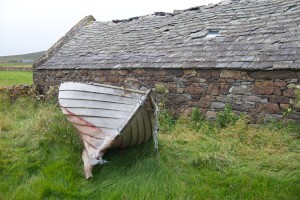
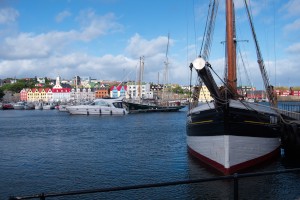
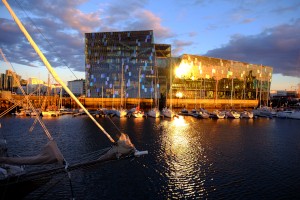
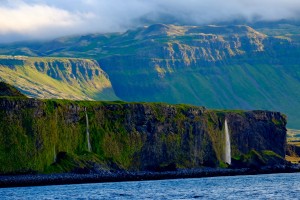
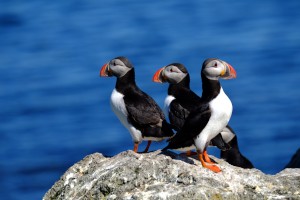
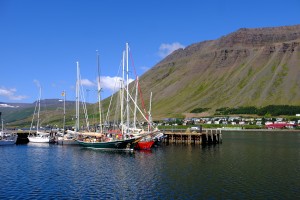
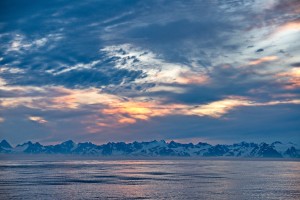
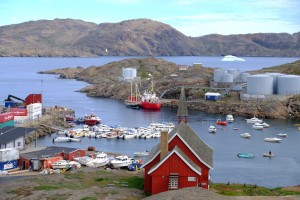
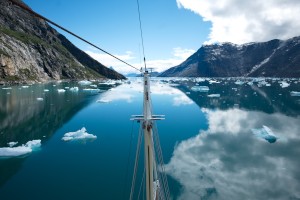
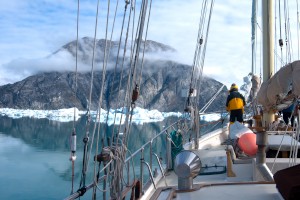
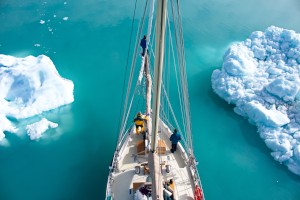
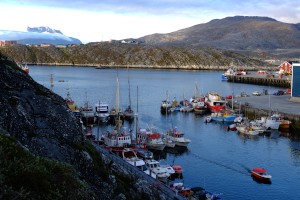
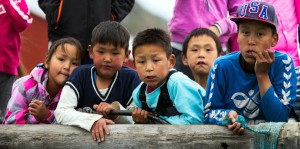
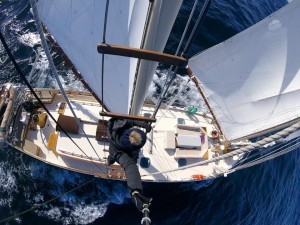
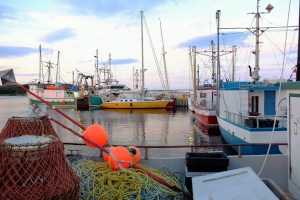
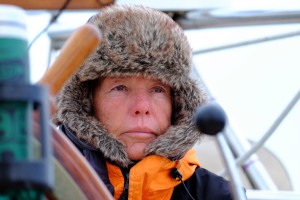
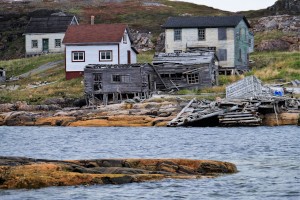
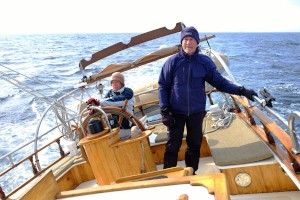
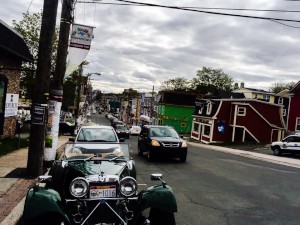
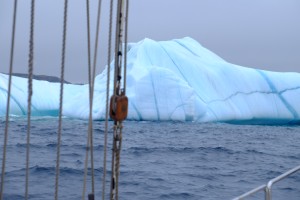
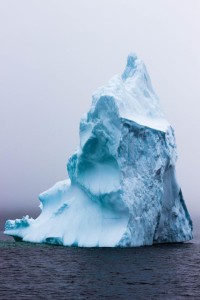
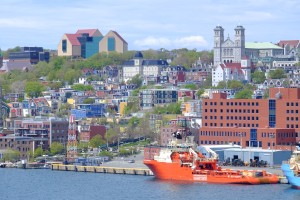
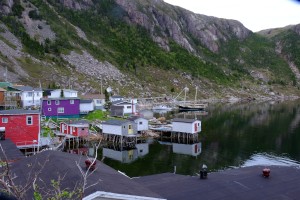
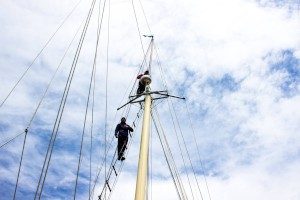
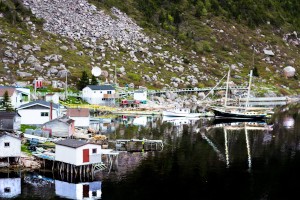
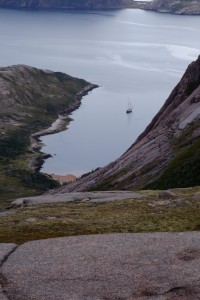
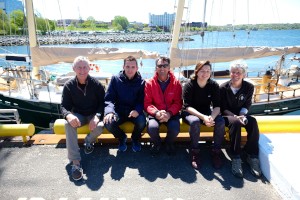
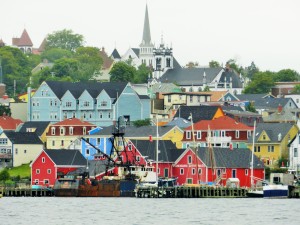
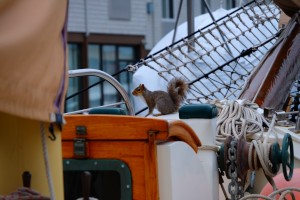
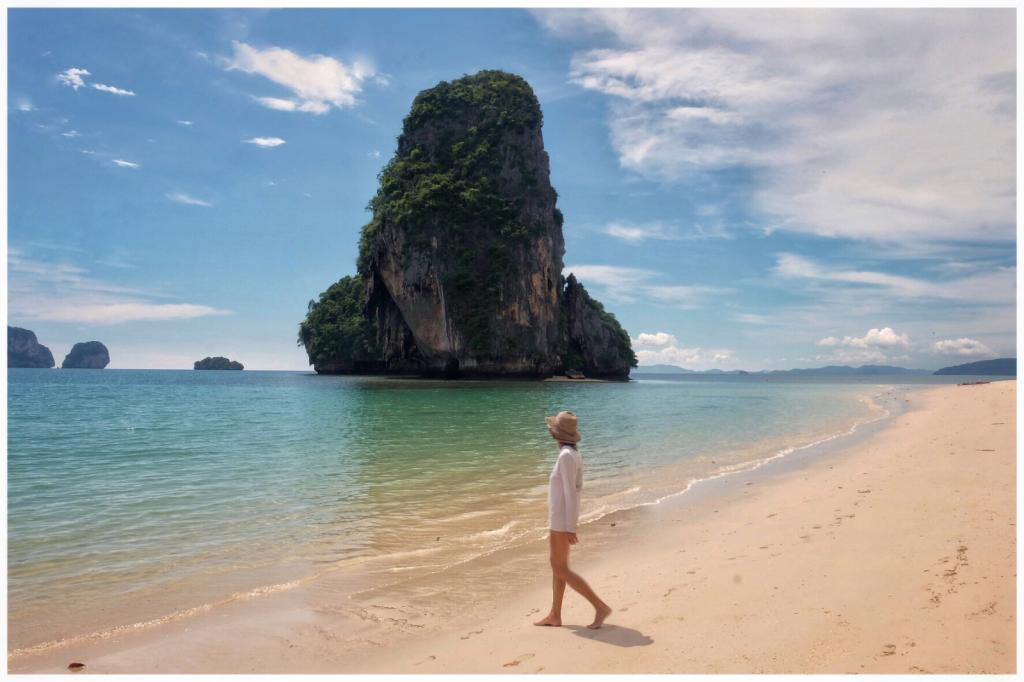
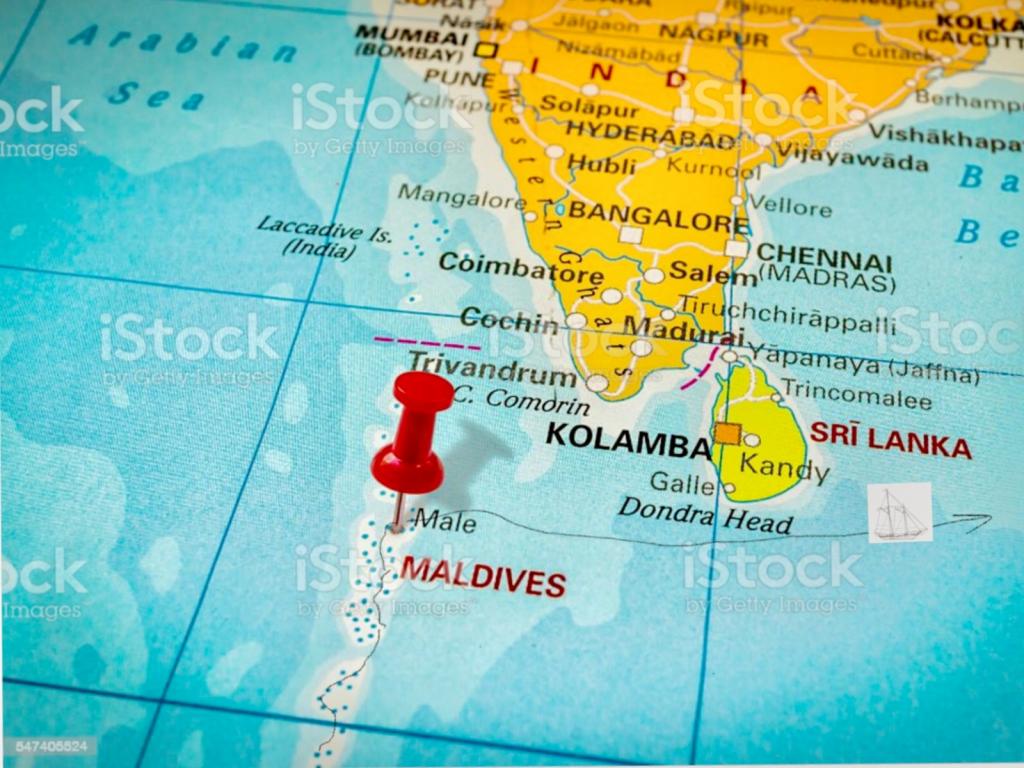


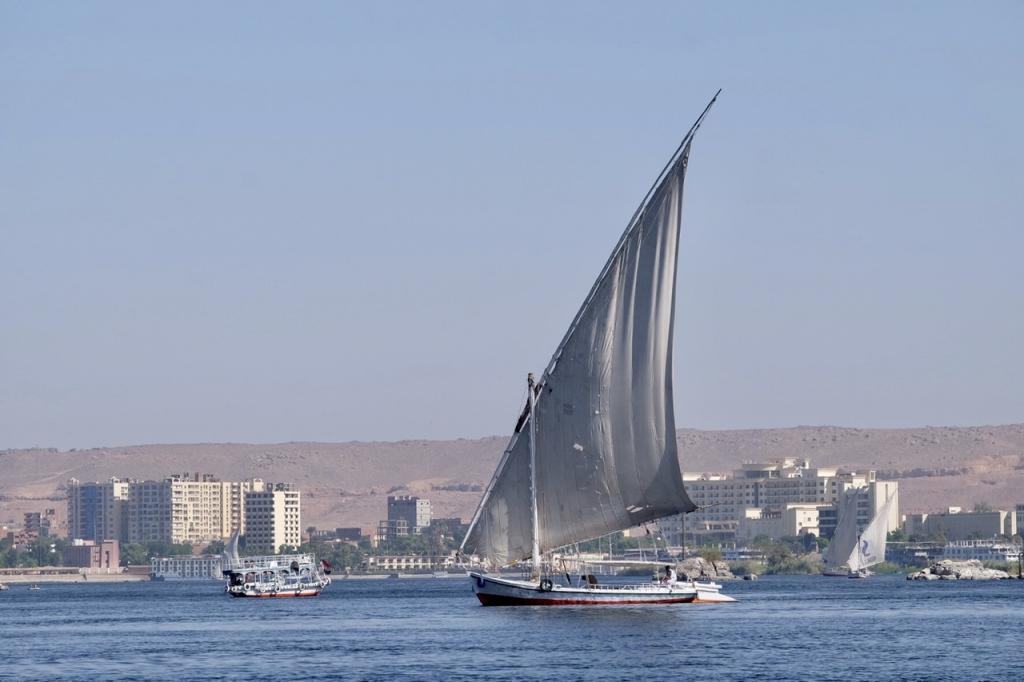
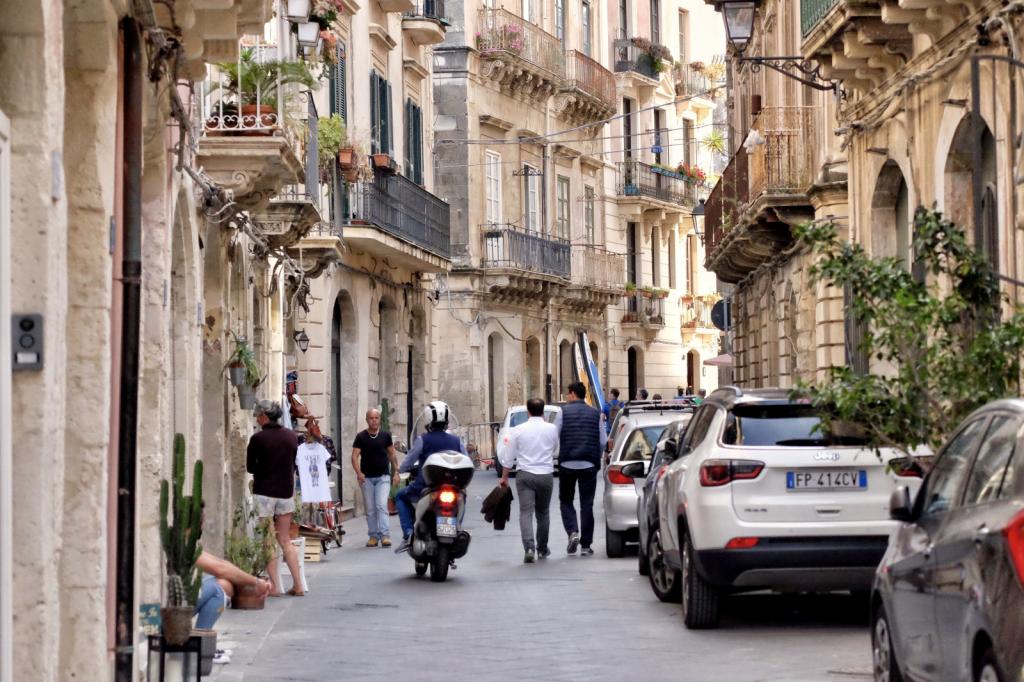
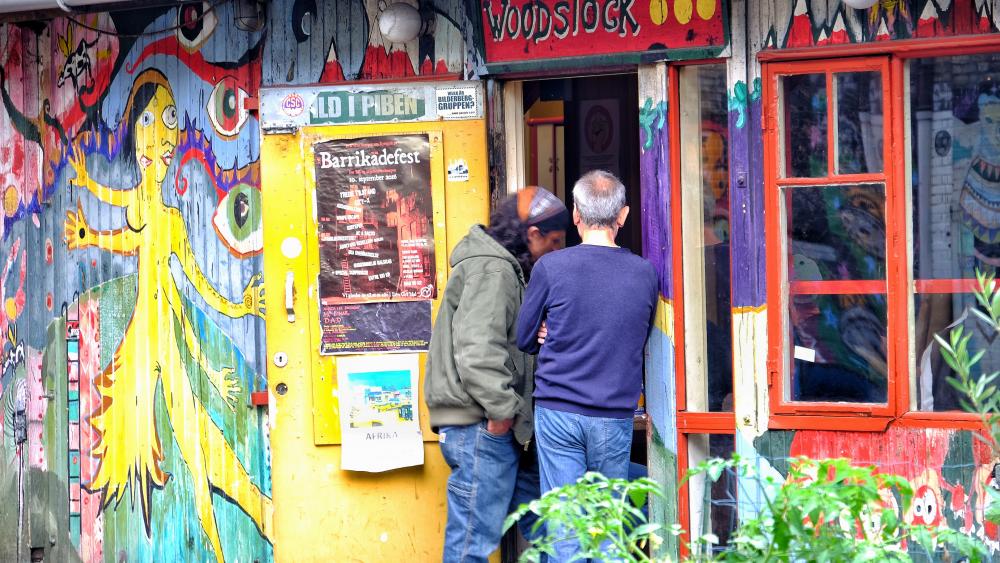
.png)

